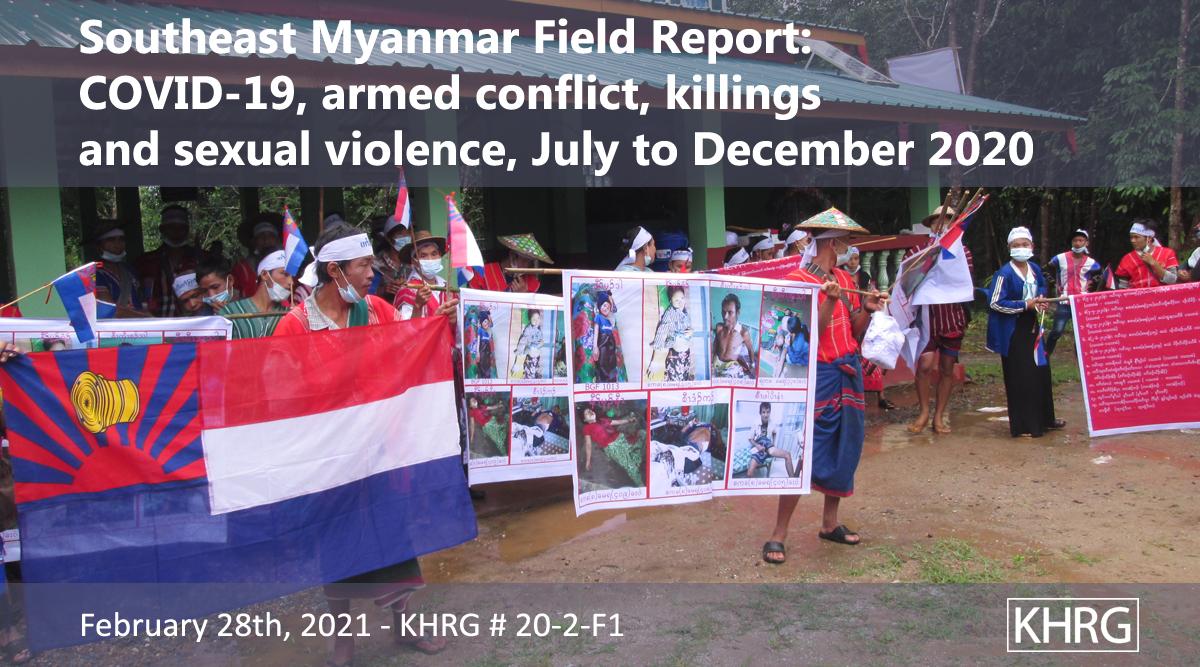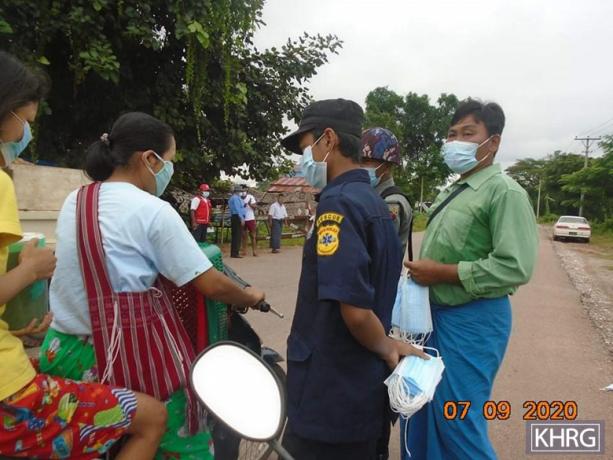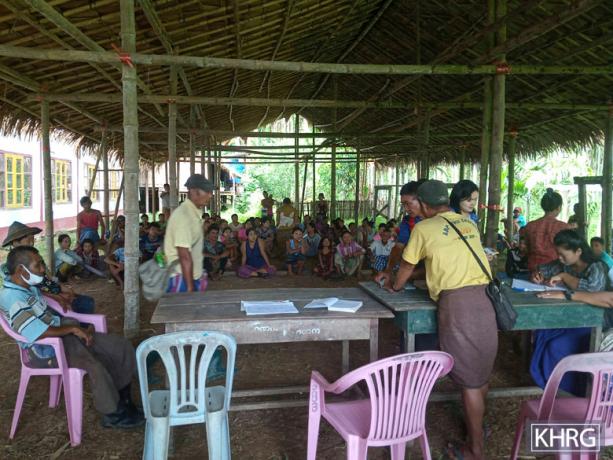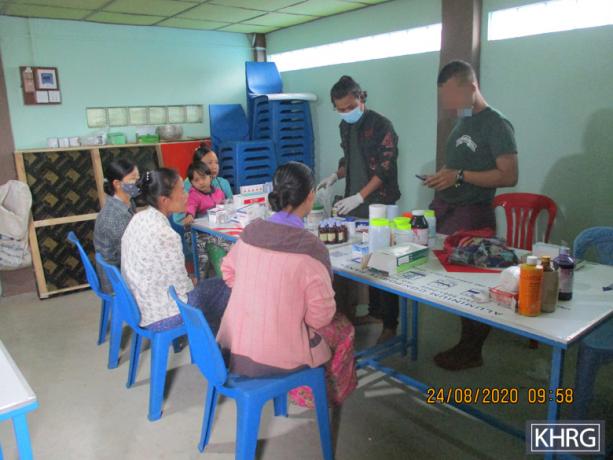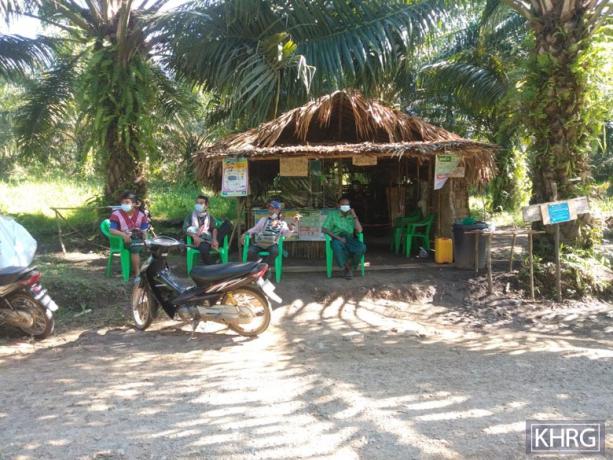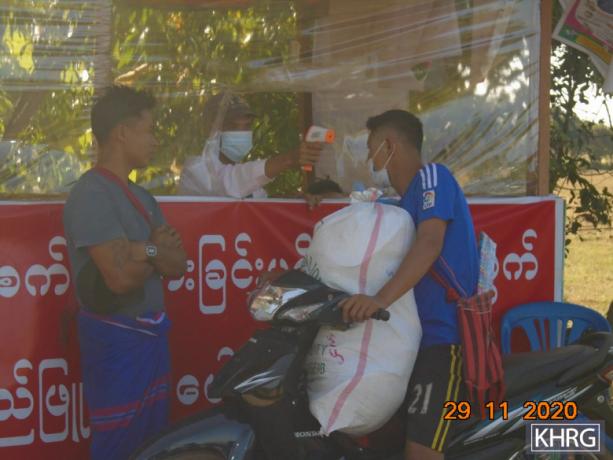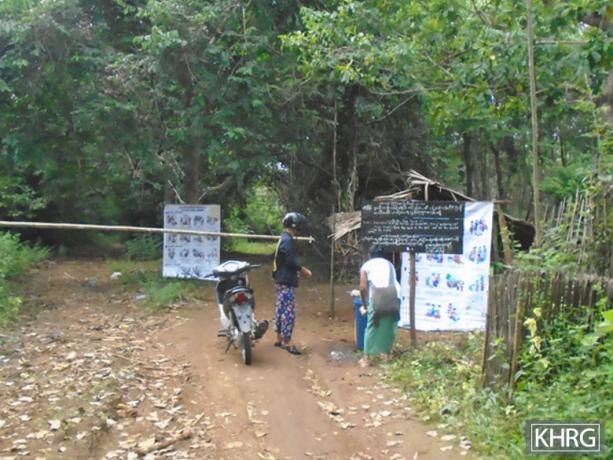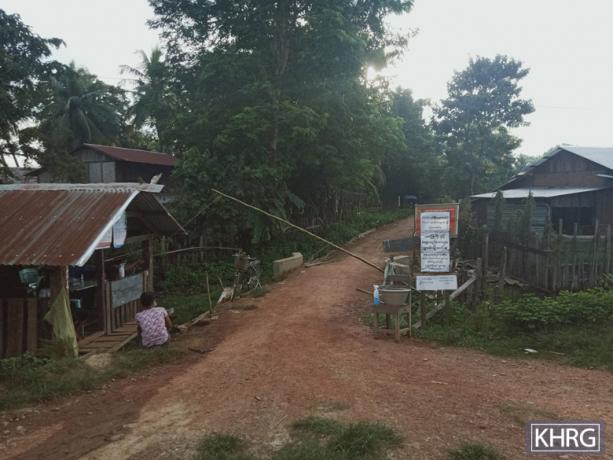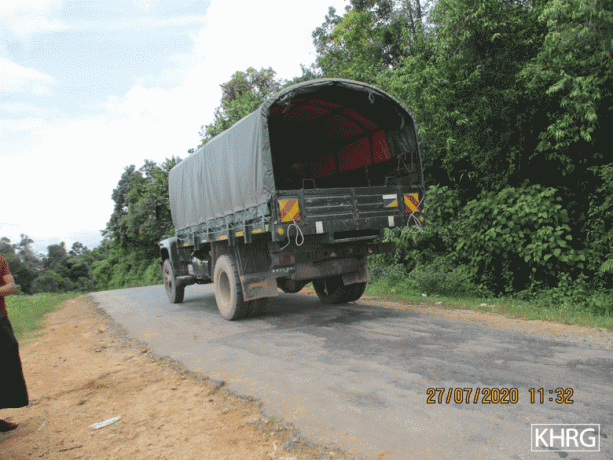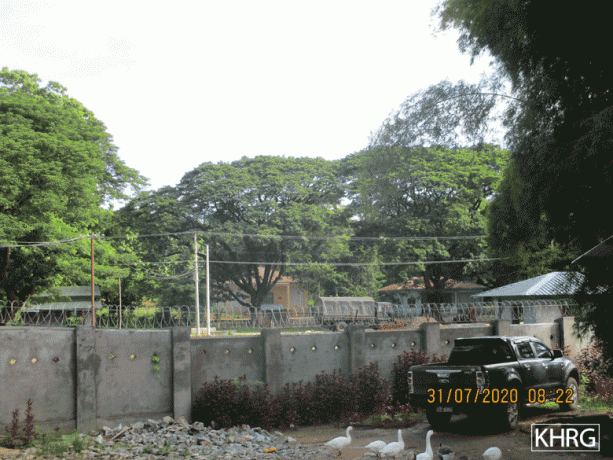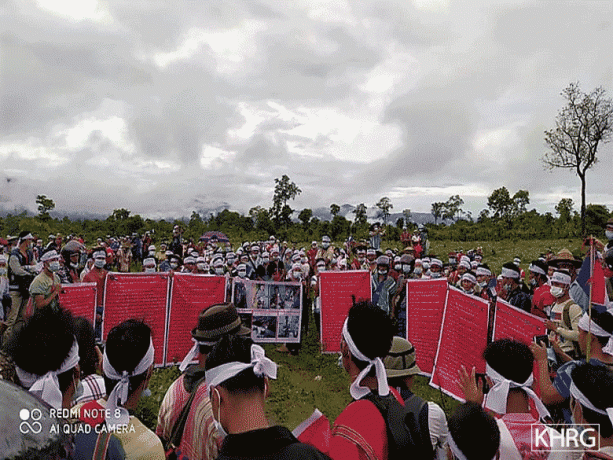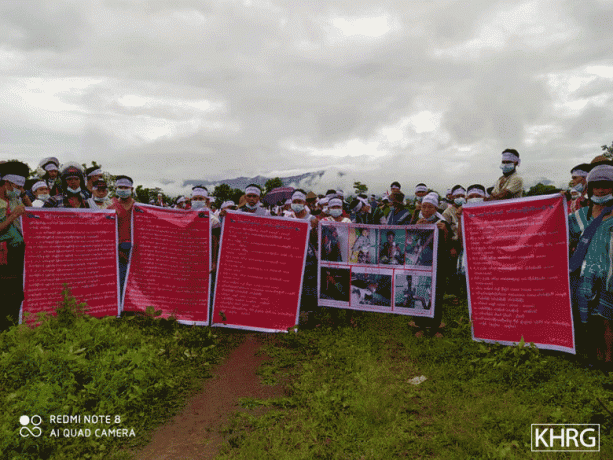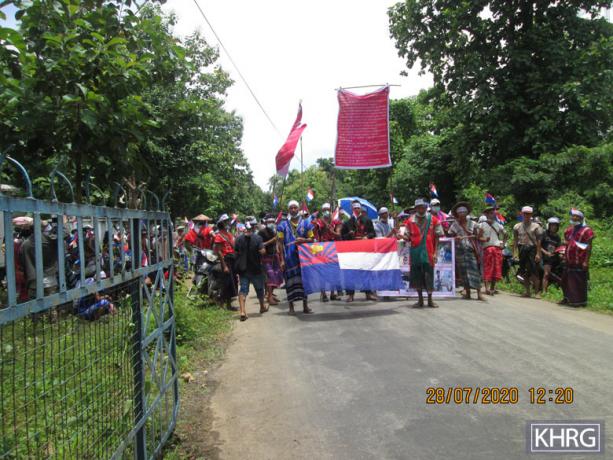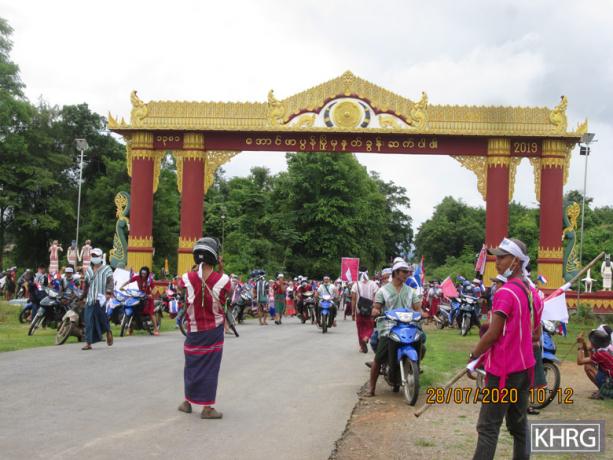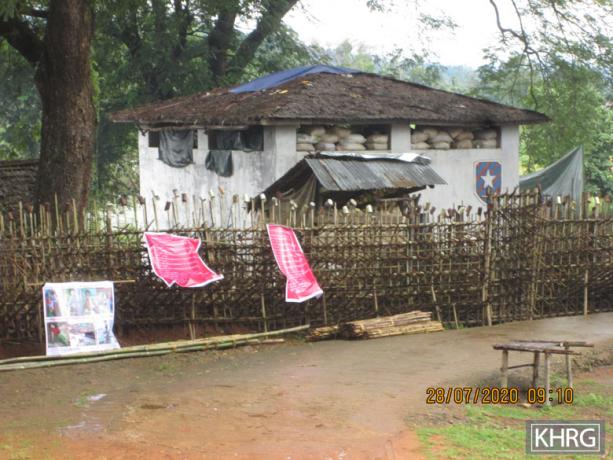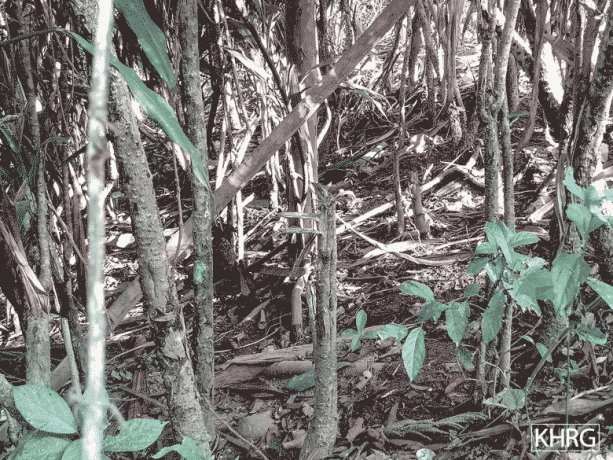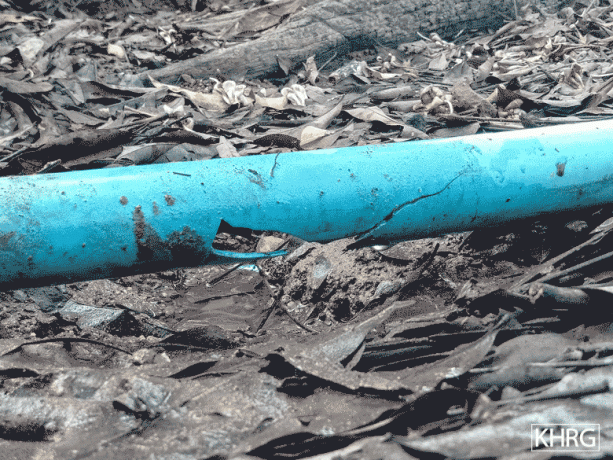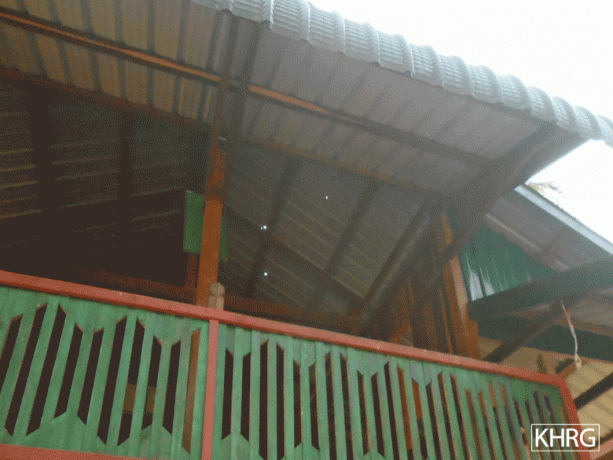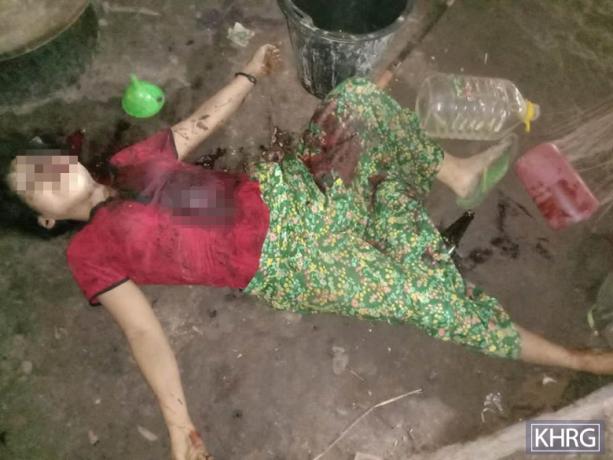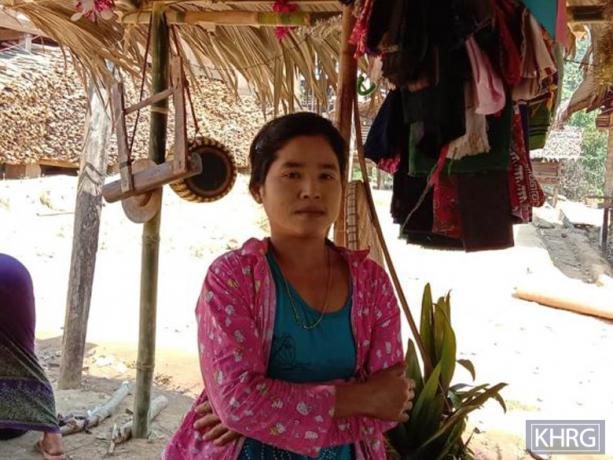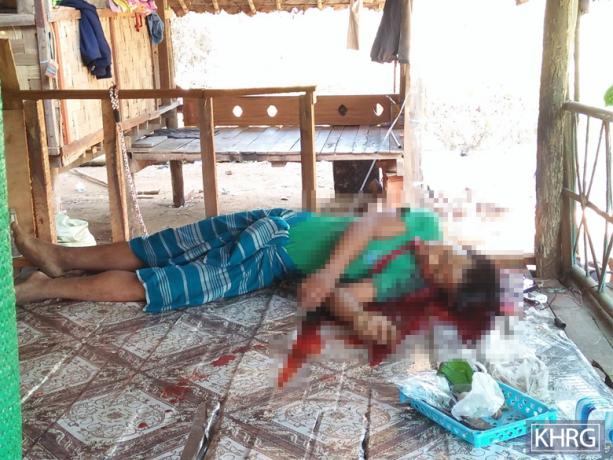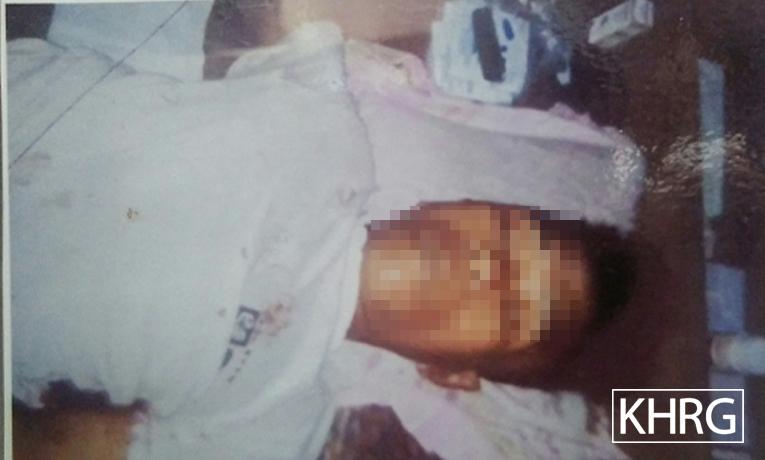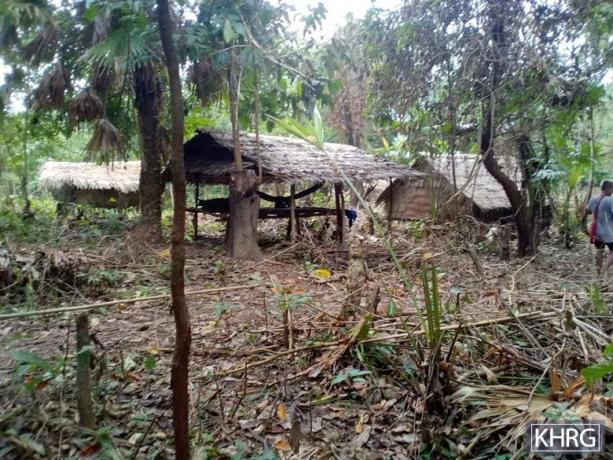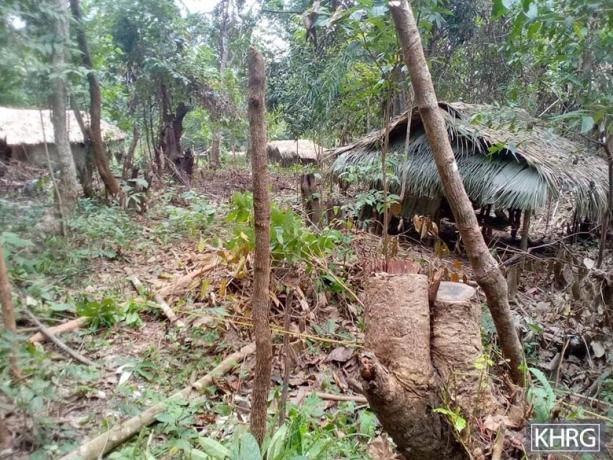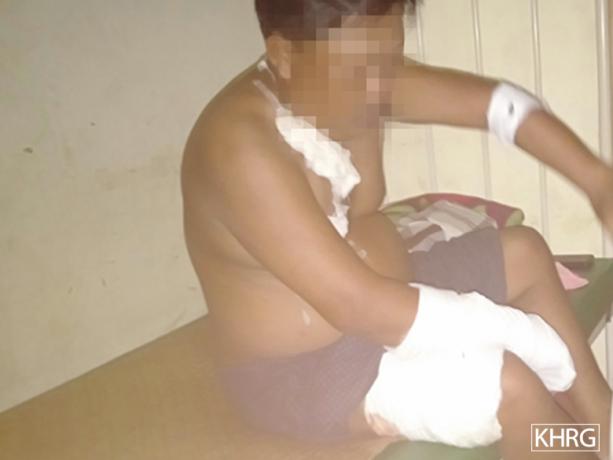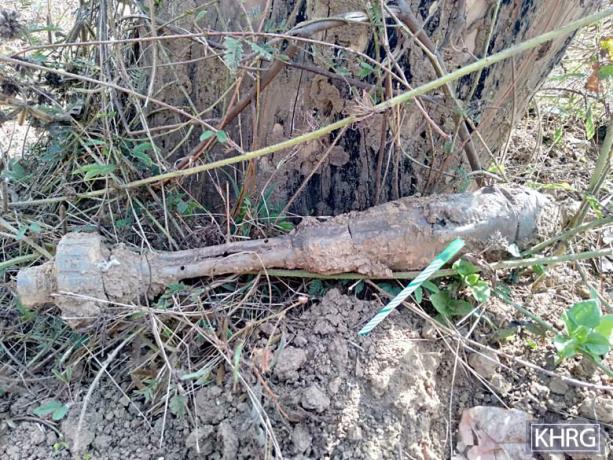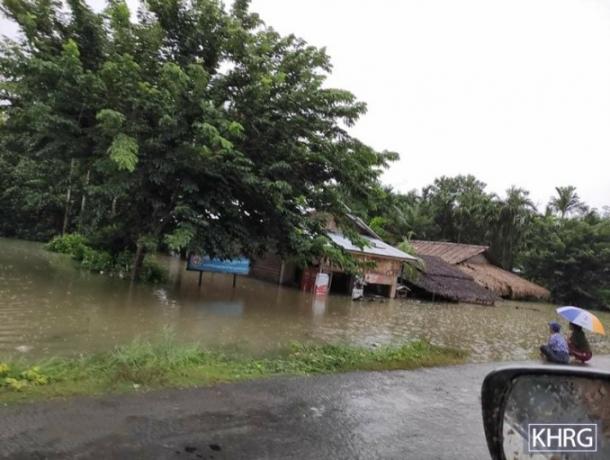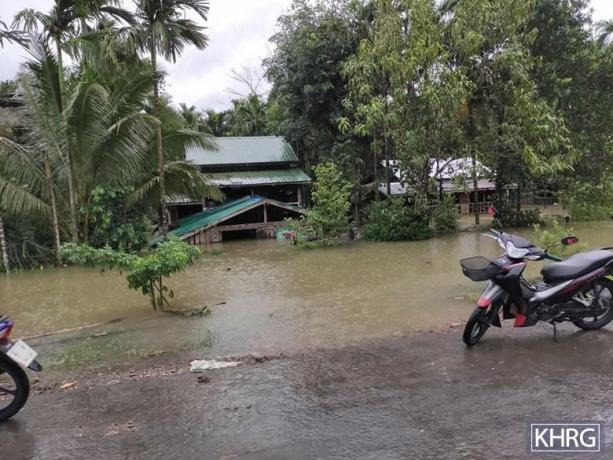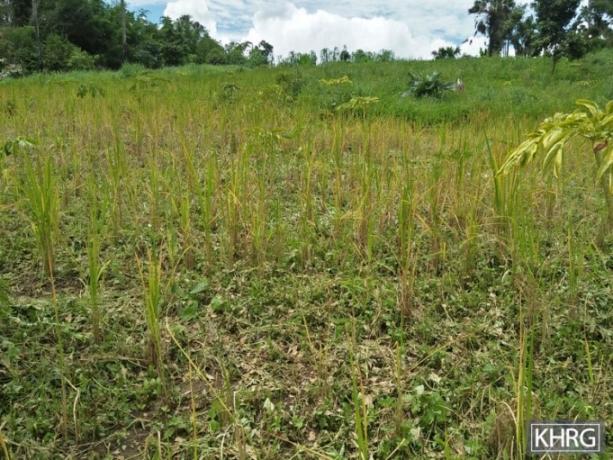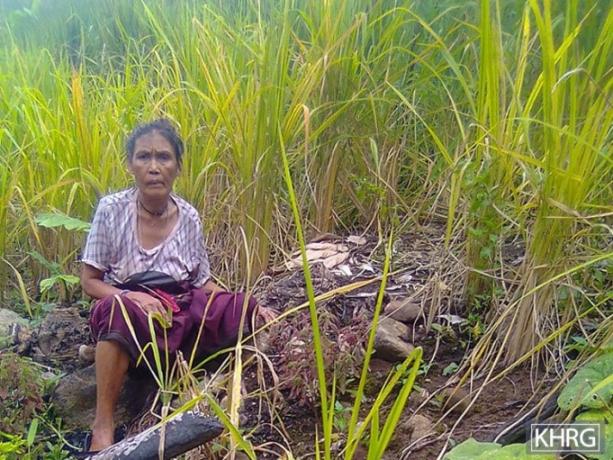Introduction
This Field Report analyses information collected by KHRG field researchers during the period between July and December 2020.
As the COVID-19[1] pandemic entered into the second wave of infections in August, rural communities in Southeast Myanmar faced new and increased restrictions that impacted their livelihood situation. Unable to access their plantations because of local lockdowns, sell their cash crops and goods, or find work as day labourers, many rural villagers are struggling to find alternatives to provide for their families. Although some financial and material aid is being provided by the Myanmar government, the Karen National Union (KNU),[2] and other organisations, that aid remains uneven in its distribution, often failing to reach those most in need. Access to education has also been heavily impacted by the second wave of COVID-19. Ongoing school closures in most areas, and policy and procedural changes for schools that do remain open have raised concerns among parents about increased school dropouts and the educational future of their children. Access to healthcare remains limited, with healthcare workers unable to access some areas, and villagers often unable to travel to the clinics closest to them. Several positive cases of COVID-19 have been reported in KHRG’s operational area. With limited access to testing and medical services, local villages are often left to figure out on their own how to best handle and contain the situation.
The Tatmadaw[3] maintained a strong presence in the northernmost KNU-defined districts over the reporting period, and kept supplying troops, weapons and ammunition to its army camps. It also resumed military road construction works in Kler Lwee Htoo (Nyaunglebin) and Mu Traw (Hpapun) districts,[4] leading to an increase in tensions and sporadic fighting with the Karen National Liberation Army (KNLA).[5] In December, the security situation in Meh Wai, Mu Traw District deteriorated dramatically after repeated Tatmadaw incursions into areas controlled by the KNU. The resulting skirmishes between the KNLA and the Tatmadaw forced dozens of households to flee their village. Fighting reportedly spread to nearby village tracts[6] and continued in early 2021. KHRG also documented several instances of indiscriminate shelling by the Tatmadaw on civilian areas in Kler Lwee Htoo and Mu Traw districts. These incidents resulted in casualties and further displacement; and also damaged livelihood areas, houses and water distribution installations in at least one village.
KHRG continued to receive information about sexual violence against women. It documented four instances of rape during the reporting period: two against children and two against adult women. Although all those cases were reported to either local leaders or the Karen National Police Force (KNPF),[7] none of the perpetrators had been formally convicted under rape charges at the time of drafting. Local authorities and law enforcement often struggled to establish the facts in the absence of witnesses or confession, resulting in lengthy investigations or the dropping of rape charges. This suggests that limited investigation capabilities are one of the main barriers preventing survivors from accessing justice. In addition, some of these cases confirmed the tendency to resort to compensation to settle sexual violence cases in Southeast Myanmar. They also highlighted other barriers to justice, such as a lack of legal awareness among village authorities and weak rule of law.
Lastly, KHRG documented three killing cases and one instance of Border Guard Force (BGF)[8] soldiers subjecting villagers to forced labour. Five civilians, including four children were also injured in the explosion of unexploded ordnance over the reporting period. This highlights that remnants of war continue to pose an unacceptable threat to villagers in some areas. In parallel, natural disasters have translated into livelihood difficulties for villagers reliant on small-scale farming in Dooplaya and Mu Traw districts; while entire communities had to leave their villages due to floods in Mergui-Tavoy District. In Kler Lwee Htoo District, large-scale gold mining operations along the Klaw Myaw, Puh Loh Kloh and Kaw Ka Loh Kloh rivers have resulted in water pollution, thus threatening the livelihoods of riverside communities. Reports from Mergui-Tavoy District also showed that ethnic villagers from remote areas still struggle to get ID cards due to discrimination from Myanmar government staff and difficulties in obtaining supporting documentation.
Part I. Major developments
A. COVID-19
KHRG previously presented information on the COVID-19 situation in Southeast Myanmar through June 2020.[9] At the time, there were no reported cases of the virus in KHRG’s operational area. In mid-August 2020, there was a rapid rise of COVID-19 infections beginning in Rakhine State, then spreading to other parts of the country, leading to a “second wave” of infections. Since September 2020, COVID-19 has spread throughout many rural areas of Southeast Myanmar, which has resulted in not only increased restrictions but greater impacts on the livelihood situation of villagers and their access to health and education services. Some financial and material support has been provided by the Myanmar government, the KNU, and other local organisations and NGOs, but that support continues to be uneven in its distribution and reach.
The information in this section is based on previously published interviews and situation updates, as well as unpublished material that will appear in a forthcoming analytical report on COVID-19.[10] Additional material covering COVID-19 during the current reporting period has been received by KHRG, but is still being processed and thus has not been included in this report.
i. Spread of COVID-19 to rural areas
COVID-19 prevention and awareness has been undertaken in rural communities of Southeast Myanmar since early 2020. During the first wave, there were no reported cases of COVID-19 from rural communities in KHRG’s operational area. In the current reporting period, KHRG has received information about new cases in some rural areas.[11] For instance, in Taw Oo (Toungoo) District, a teenage girl in Hta Mon village tested positive for COVID-19 on October 14th 2020, and was sent to the Toungoo hospital for treatment, where she later recovered. There was no lockdown of the community after the new case was found, however, local villagers followed prevention policies by wearing masks all the time and washing their hands frequently.
Secondly, a local villager tested positive for COVID-19 in Dwe Lo Township, Mu Traw District in September 2020. Three families in contact with the patient were put in quarantine and were heavily watched by the Myanmar Police Force to ensure that they followed prevention measures and limited their contact with other villagers.
ii. Awareness and prevention measures
COVID-19 awareness and prevention activities continued to be carried out by the local KNU and the Myanmar government, as well as organisations such as Karen Department of Health and Welfare (KDHW),[12] Karen Education and Culture Department (KECD),[13] and Karen Women Organisation (KWO). The KNU and the Myanmar government also continued to set up quarantine centres in their areas.
In Noh T’Kaw (Kyainsiekgyi) Township, Dooplaya District, the KDHW provided training for villagers and health workers about checking temperatures and monitoring screening checkpoints. The KNU and health worker teams cooperated to provide awareness training to local communities in Waw Ray Township, Dooplaya District once a month. A villager in Noh K’Neh village, Kyone Wine village tract, Bilin Township, Doo Tha Htoo (Thaton) District also stated that the local KWO sewed over 1,000 fabric masks and provided it to the local communities. In Taw Oo District, a villager from Zee Pin Ka Lay village, Zee Pin Ka Lay village tract, Daw Hpa Hkoh (Thandaunggyi) Township stated that Medical Action Myanmar (MAM) provided soap and masks.
iii. Aid and support
KHRG previously mentioned (in its October 2020 news bulletin on COVID-19,[14] covering March to June 2020) that the Myanmar government had made provisions to provide cash and material support to vulnerable households and at-risk populations. As of June, few had received this support, and only villagers in government-controlled and mixed control areas were included. This continues to be the case.
Local communities have been facing food shortages and employment issues due to COVID-19 restrictions. They are also now more vulnerable to the infection itself since its spread into rural areas. Many villagers are surviving through government and humanitarian aid and support. The aid distribution has however varied in amount and frequency between villages. The Myanmar government provided rice, oil, salt, masks, hand gel, thermometers and/or direct financial aid to some local communities in government-controlled and mixed control areas. Most aid has prioritised people with critical livelihood situations. The poor, people without any property or land, and the elderly are considered the most in need. In Leik Tho Town, Daw Hpa Hkoh Township, Taw Oo District, the Myanmar government provided each elderly person above 60 years old with 50,000 kyats [USD 35.48].[15] In some areas, the Myanmar government provided 20,000 kyats [USD 14.19] to each household. For instance, local people in Thandaunggyi Township, Taw Oo District have received financial aid from the Myanmar government every three months since the outbreak of COVID-19 (they have already received three payments). In Kaw Baw village, Lay Nya Bu Pyay (Lanya Bokpyin) area, Mergui-Tavoy District, villagers received 20,000 kyats in financial aid from the Myanmar government but they had to give 5,000 kyats [USD 3.55] to the village head for transportation fees.
Uneven aid distribution by the Myanmar government has led to dissatisfaction and arguments among local villagers. Some communities have voiced their discontent about receiving unfair aid and the lack of transparency in aid distribution. For instance, many villagers in Mi Taing Taw village tract, Ler Doh (Kyaukkyi) Township, Kler Lwee Htoo District reported to KHRG on October 2nd 2020 that only 35 percent of the households received the government cash handout and some poor villagers were still left out despite their critical livelihood situation. After a group of villagers reported this issue to the local authorities, the village tract administrator met with villagers on October 8th and he re-arranged fair aid for them.
Problems with aid distribution have also resulted from management issues. In Mergui-Tavoy District, KHRG received a report that villagers in Wa Hkaw Doh village, Kleh Mu Htee area, K’Ser Doh Township, never received aid from the government, even though eligible, because of poor monitoring and assessment of the situation by the village tract administrator.[16] Local villagers in nearby communities had however received aid from the Myanmar government four times already.
The KNU government and local community organisations have also provided humanitarian aid to local areas, especially remote areas where the Myanmar government aid does not reach. A villager from Aa--- village, Meh T’Hkreh village tract, Noh T’Kaw Township, Dooplaya District expressed that “I have not seen any direct support to our township from other organisations except for CIDKP”. In Noh K’Neh village, Kyone Wine village tract, Bilin Township, Doo Tha Htoo District, the KWO provided 10,000 kyats [USD 7.10] as well as one bottle of oil, potatoes, eggs and four bowls of rice to the families who are in the most difficulty.
iv. Movement restrictions
Restrictions on movement started in early 2020, after the first outbreak of COVID-19. Travel restrictions in Southeast Myanmar were ordered by both the Myanmar government and the KNU. In addition, some communities developed their own policies, like barring entry to their village, to prevent the spread of COVID-19 in their area. Requiring villagers to obtain a travel (permission) letter from the local authorities has been one of the main policies implemented throughout the region. Typically, the letter is usable for only one trip and does not allow for overnight stay.
In some areas, the restrictions have become stricter during the second wave of COVID-19 because the virus has now reached the rural communities. A villager from Htee Hpa Htaw village, Way Hk'Nah village tract, Waw Ray (Win Yay) Township, Dooplaya District stated: “The second wave is worse than the first wave. We were able to go to each other during the first wave but now we cannot work or go anywhere at all […] as more people are dying from COVID-19.” Another villager added: “We can go anywhere within Maw village tract area. However, we are completely restricted from going to other village tracts like K’Yeh Theh”. Local armed groups continue to set up checkpoints between areas specifically to monitor people travelling around.
In some areas, travel restrictions have loosened to address villagers’ livelihood concerns. For instance, some local authorities have turned to allowing travel for a limited number of days or on specific days. In the case of Noh K’Neh village, Kyone Wine village tract, Bilin Township, Doo Tha Htoo District, a villager explained that “The village head organised a meeting and told the villagers that they can travel two days a week to buy food […] with a permission letter from the village head.” In parts of Mu Traw District, local leaders have allowed villagers to travel on Mondays and Fridays in order to buy food and supplies.[17]
As reported during the first wave of COVID-19, fees attached to travel (permission) letters have contributed to the livelihood challenges of rural villagers. Because issuance takes place at the village or village tract level, and no wider regulation seems to exist, determinations about fees tend to be at the discretion of local leaders. Villagers in Noh T’Kaw Township, Dooplaya District noted that areas vary regarding fees. Even though at the township level letters are issued free of charge, some villages and village tracts within Noh T’Kaw Township are charging a fee. In Meh T'Kreh village tract, villagers were being charged 1,000 kyats [USD 0.71] per letter, but now that fee has been removed, upon a decision by local leaders.
v. Livelihood impacts
During the second wave of COVID-19, villagers reported in their interviews with KHRG that their livelihood situation is getting worse as the restrictions continue. Most villagers normally secure their livelihood through plantation work, farming, selling cash crops and goods, and casual day labour. Road closures ordered by the Myanmar government and the KNU have affected villagers’ ability to travel between villages and towns. Unable to go to their work places and plantations, or sell their crops, many villagers are now facing food shortages and livelihood difficulties. “We would like to travel and work like before. […] Now we do not have enough food and we find it difficult to afford even a single protection mask” said one villager in Dooplaya District.
The requirement of getting travel permission from local authorities creates challenges for the villagers to trade/sell their cash crops, as well as to buy food and goods in town. A villager from Taw Oo District explained: “Villagers are allowed to travel [but only] within limited timeframes, so they cannot sell as much as they want. For our village, we have to go early to Nyaung Pin market, Toungoo Town in order to sell our stuff. We need to get travel permission before we go. The market closes at noon and other small markets close at 3 or 4 pm. We have to rush. If we are late, we cannot buy or sell as much as we want.”
During the first wave of COVID-19, some villagers returned from Thailand because of employment issues and border closures, but are now facing livelihood issues back in Myanmar. One interviewee in Noh K’Neh village, Kyone Wine village tract, Bilin Township, Doo Tha Htoo District noted that those who came back from abroad during the COVID-19 pandemic are now stuck in Myanmar, unable to return to Thailand for work because of the travel restrictions. They are not able to find work in Myanmar either.
Widows, people with disabilities, the elderly, and poor families with many children are also at increasing risk of facing food shortages during the COVID-19 lockdown, particularly as it extends for months on end. A villager from Ab--- village, Noh T’Kaw Township, Dooplaya District who has six children to feed expressed his concern: “Since the spread of COVID-19, there have been many problems for us. We cannot travel anywhere and we do not have enough food as well. […] In this situation, we have to ask for food from our relatives. […] If we are unfortunate, we might have to survive by eating porridge meal. We cannot even guarantee having porridge if the food shortage gets worse.” He continued to explain that he occasionally received bowls of rice and meat from relatives but it was enough for just a couple of meals because he has six children to feed. They are surviving on vegetables from the forest and eat sparingly in order to have something for the days to come.
As the pandemic continues and leads to on-going and/or greater restrictions, the livelihood situation of villagers in rural areas becomes more critical. It is situations like this that reveal how dependent rural villagers are on regular access to towns, and the need for greater provisions that specifically support the challenges of rural villagers, including the development of rural to urban trading solutions that allow rural villagers to continue selling their crops despite travel restrictions.
vi. Education system
At the time of the lockdown during the first wave of COVID-19, most schools had already ended classes for the year. Because of that, few education problems were reported at that time, aside from some schools facing challenges administering end-of-year exams. The start of the new school year had already been postponed [from June] to July or August in the hopes that the situation would improve. However, escalation of the COVID-19 virus throughout Myanmar, including rural areas beginning in September, led to challenges for schools to re-open or remain open. Some schools could re-open for a short period of time but later closed down for the protection of students and teachers. KHRG received reports that all Myanmar government schools have closed down completely, as have some mixed schools, whereas some KECD schools are still running.
Schools that have remained open have adopted a variety of prevention measures. A villager from Paw Ner Moo village, Meh T'Hkreh village tract, Noh T'Kaw Township, Dooplaya District explained “all of our KECD schools are open but the teachers and the students have to use masks. They have to screen their temperature before going inside the school.” In Daw Hpa Hkoh Township, Taw Oo District, when government schools re-opened in mid-July, the new COVID-19 prevention policies, which included mask wearing and strict student drop-off/pick-up rules, created issues for parents who have financial and livelihood problems. One of the students also noted that, “There are more chances that students will have to drop out or quit school when they fail to follow the procedures for preventing the virus.”[18]
The closing of schools has impacted students and teachers, as well as parents, in various ways. Villagers in some parts of Doo Tha Htoo, Taw Oo, and Dooplaya districts reported that children from poor families spend their free time helping their parents in the plantation or harvesting paddies. Some parents who are better off financially have managed to continue with the education of their children at home by providing the lessons themselves. However, poorer parents are not able to do this because they are busy struggling for their livelihoods. Some older students have been helping their parents and working to save money for their future education. With many students not able to attend school, parents are concerned about the long-term impacts of these educational delays. For instance, one villager in Noh K’Neh village, Kyone Wine village tract, Bilin Township, Doo Tha Htoo District noted that seeing teenage children enjoy their time outside of school creates worries for the parents that their children will lose interest in studying altogether. In K'Ser Doh Township, Mergui-Tavoy District, children themselves are complaining about not having classes: “We are so bored and we are getting older with no worth [not able to improve our skills and knowledge through education]. We cannot study and our time is wasted [with nothing to do].”
Since school teachers cannot teach in school anymore, they have had to find other ways to earn an income. According to one interviewee in Zee Pin Ka Lay village (Maing N’Hsel), Thandaunggyi Township, Taw Oo District, teachers in rural communities are engaging in other activities such as selling goods and working on rubber, betel nut and cardamom plantations.
vii. Healthcare access
Most rural communities access healthcare in their [local] area, nearby towns or across the border. Many community clinics do not have the capacity to treat serious diseases so villagers must access healthcare in nearby towns and by crossing the border into Thailand. Some areas have faced greater challenges in accessing healthcare during the second wave of COVID-19. For instance in Noh T’Kaw Township, Dooplaya District, villagers who have to cross the border for healthcare treatment are allowed to go only with one driver and one caregiver. They also have to get a travel letter from local authorities.
In Zee Pin Ka Lay village tract, Daw Hpa Hkoh Township, Taw Oo District, villagers are facing healthcare challenges because of the travel restrictions. They cannot get their children vaccinated by the doctor because those healthcare services lie outside the area in which they are allowed to travel. In Kya Inn village, Kyain Shwedo village tract, Noh T’Kaw Township, Dooplaya District, local villagers have also been facing problems related to healthcare. One villager mentioned that the nurses in the clinic and hospital now avoid direct contact with their patients. They only question them about their health condition and provide medicine.
viii. Screening checkpoints
COVID-19 screening checkpoints continue to be set up throughout Southeast Myanmar, including rural areas. Depending on the location, the screening checkpoints are usually monitored by some combination of local health workers, soldiers, police, local authorities, and villagers. In some cases, villagers run the checkpoint along with health workers and other responsible persons, rotating on a daily basis. Some villages have appointed specific villagers to monitor the screening point, whereas others allow the villagers to volunteer to take part. In either case, most villagers working the checkpoints did not receive proper training about COVID-19 prevention or screening.
The activities at the checkpoints typically consist of measuring temperatures, providing masks, recording the names of villagers, and providing and checking (permission) letters for villagers who travel. The interviews from Taw Oo and Dooplaya districts mentioned that when the screening checkpoint found COVID-19 suspected people, they sent them to the local quarantine centre right away. But in some areas, screening measures do not seem to be adhered to properly. One villager in Zee Pin Ka Lay village tract, Thandaunggyi Township, Taw Oo District reported that at their village checkpoint, there is no thermometer to actually check people’s temperature. Yet, at the KNU checkpoint in N’Hsel N’Maing area, where temperatures are checked, people with a high temperature are given medicine, but do not seem to undergo quarantine or further testing.
Some screening checkpoints in mixed control areas were removed by the Tatmadaw and Myanmar government during the first wave of COVID-19. Although there have been fewer reported cases of checkpoint burning or dismantling by the Tatmadaw during this reporting period, some areas are still facing pressure from the Myanmar government regarding their screening checkpoints. In September 2020, local people built two screening points in Kaw Baw and S’Tein villages, Lay Nya Bu Pyay area, Mergui-Tavoy District. However, the screening checkpoints remain non-operational because the Myanmar government has not given them permission to do so. As such, local people worry about the uncontrolled movement of people and the risk of spreading the virus in the community.
ix. COVID-19 and the general election
KHRG expects to publish a fuller report on the 2020 general election at a future date. Included here are a few details about the campaigning that took place in rural villages prior to the election specifically in relation to the COVID-19 situation.
With the restrictions on travel and public gatherings becoming more restrictive due to the rise in COVID-19 cases throughout Myanmar, some villagers expressed concerns that political parties campaigning in their area were not following safe practices. The Ministry of Health and Sports had declared a ban on large public gatherings but those policies were not adhered to by the campaigning political parties in some areas. Villagers in K'Ser Doh Township, Mergui-Tavoy District remarked: “We cannot worship together or gather in groups. But we see that [political] parties are campaigning in groups and village leaders are calling almost every villager to come and listen to the campaign speech.” Local villagers added: “We do not understand the situation anymore. The disease [COVID-19] is not decreasing but actually increasing throughout the country. […] We did not want to go when the parties came to do campaigning but we were afraid that people would see us as careless [irresponsible], so we had to go. We worry about getting the disease [COVID-19] as well because the party representatives are not people in our community.”[19]
In other areas where COVID-19 restrictions were more fully adhered to, campaigning political parties were often only able to meet with village leaders. This was case in Noh T’Kaw Township, Dooplaya District: “Since there is the COVID-19 [pandemic], they [political parties] carried out their activities under our community protection policies. We restrict the entrance of outsiders in our village. So, not every villager could meet with them. Since the Myanmar government also allows only 30-50 people to gather, the parties mostly only met local village leaders.”
B. Militarisation and fighting
The Tatmadaw remained particularly active in the northernmost KNU-defined districts over the reporting period and resumed military road construction works despite opposition by the KNU and the local population.[20] It also trespassed into KNU-controlled areas on several occasions. This triggered skirmishes with the KNLA, notably in Mu Traw District. In both Mu Traw and Kler Lwee Htoo districts, KHRG also documented several instances of indiscriminate shelling on villages and livelihood areas by the Tatmadaw, resulting in casualties, displacement and property damage.
i. Militarisation
The Tatmadaw maintained an important activity in Taw Oo District over the reporting period and kept sending ammunition, rations and troops to its frontline camps in the region, raising security concerns among local communities. In October 2020, live fire artillery exercises by the Tatmadaw put villagers’ lives at risk and resulted in the destruction of agricultural land in Daw Hpa Hkoh Township.
In Mu Traw District, KHRG also documented an increase of Tatmadaw troops in the context of military road construction activities in Bu Tho Township. The heavy Tatmadaw presence in Lu Thaw Township has continued to translate into restrictions to the freedom of movement of local villagers. Local communities held several protests to ask for the withdrawal of the Tatmadaw from the area, to no avail.
a. Taw Oo District
On 5th July 2020, three military trucks transporting soldiers went from Toungoo Town to the Tatmadaw camp in Baw Ga Le Town, Daw Hpa Hkoh Township.[21] In July 2020, 20 Tatmadaw trucks transporting rations and military personnel to frontline camps travelled from Toungoo Town to Yar Don Town. On November 10th 2020, 10 Tatmadaw trucks left the Southern Command Headquarters to send rations to frontline army camps in the eastern part of Baw Ge Le Town. On November 28th 2020, two Tatmadaw trucks transported two 105 mm guns from the Southern Command Headquarters to the Ba Yint Naung military training school in Daw Hpa Hkoh Township. The movement of convoys raised security concerns among villagers in Taw Oo District. Local communities worry that this sustained Tatmadaw activity might lead to fighting between the KNLA and the Tatmadaw after the election [November 8th 2020].
On October 2nd 2020, Tatmadaw soldiers from the Ba Yint Naung military training school conducted artillery live fire exercises. They fired mortar rounds at Pot Ka Lay Kho and Kel Kee Kho mountains. Pot Ka Lay Kho Mountain is located between Shwe Nyaung Pin village and Nan Chen Kwin village; and Kel Kee Kho Mountain is located between Maung Nwe Gyi village and Nan Chen Kwin village, Maung Nwet Gyi village tract, Daw Hpa Hkoh Township. During this exercise, more than 100 mortar shells were fired at local mountainside cardamom plantations. As the Tatmadaw did not inform the local population in advance about this live fire exercise, some local villagers were working on the plantations that were targeted at the time of the incident. These villagers had no choice but to run back to their villages. Nobody got injured but a local villager told KHRG that the local cardamom, durian and betel nut plantations had been damaged by the mortar shells.[22]
Military training activities resulting in the damage of plantations and farmland are a direct violation of section 5(a) of the Nationwide Ceasefire Agreement (NCA),[23] which states that the Tatmadaw (and other signatories) must not engage in destruction of property in ceasefire areas. The Tatmadaw’s actions also show complete disregard for the safety and security of villagers, in breach of its obligation to “ensure the security and development of civilians living in ceasefire areas” pursuant to Section 9 (p) of the NCA.
b. Mu Traw District
On July 5th 2020, Operation Commander Thet Paing Zaw and around 400 soldiers from Light Infantry Battalion [LIB][24] #405, LIB #410 and other battalions under Military Operations Command [MOC][25] #8 joined the LIB #434, LIB #341, LIB #340 and Infantry Battalion [IB][26] #19 troops that were based in Meh K’law village tract, Bu Tho Township, Mu Traw District. These reinforcements were previously based in the Dawei area, Mergui-Tavoy District.
On July 6th 2020, Commander Thet Paing Zaw held a meeting at the LIB #434 army camp in Meh K’law village tract. It was attended by village administrators and elders from A---, B---, C--- and D--- villages, Meh K’Law village tract. Thet Paing Zaw told them that his troops came to ensure the safety of local communities during the general election. However, local communities reported that their presence was linked to the contentious road construction activities that the Tatmadaw is conducting in the area, as soldiers were seen guarding the roadwork. If their presence was indeed for guarding the roadwork, such activities would likely violate Section 5(c) of the NCA, which states that the signatories must “avoid troop reinforcements in the ceasefire areas other than the provision of administrative support.”
Villagers in Meh K’Law village tract told KHRG that they were afraid to go to their hill fields because of this increased Tatmadaw presence. They also reported seeing military trucks every day and every night from June 2020 onwards, but they do not know what these trucks were carrying. One week after the general election, the troops under MOC #8 started returning to the Dawei area one battalion at a time.[27]
On July 28th 2020, around 5,000 villagers from 10 village tracts (Ma Htaw, Meh K’Law, Meh Hku, Meh Nyu, Meh Mweh, Day Wah, Kyaw Pah, Lay Poe Hta, K'Ter Tee, Htee Th'Blu Hta) in Bu Tho and Dwe Lo Townships protested to demand justice for the abuses perpetrated by the Tatmadaw and call for the withdrawal of their army camps from the area. One group of demonstrators marched from Ma Htaw to Hpapun, and another group marched from Taung Thone Lone to Ka Ma Maung.[28] Although this particular protest was triggered by the killing of Naw Mu Naw, a local Karen women by two Tatmadaw soldiers on July 16th (See Part II), similar demonstrations against the military road construction activities and increased Tatmadaw presence have been taking place in both Mu Traw and Kler Lwee Htoo districts since 2019.[29]
On August 9th 2020, 2,885 villagers from 65 villages in Hkay Poo, Naw Yoh Hta, Ler Muh Plaw and Saw Muh Plaw village tracts, Lu Thaw Township held another protest to call on the Tatmadaw to withdraw their army camps from the Khaw Daw Hkoh, Hsa Law Kyoh, Wah Klay Too, Htaw Muh Pleh Meh, Koh Kaw Day and Paw Hkay Hkoh areas. The demonstration took place in Thee Neh Poo place,[30] Naw Yoh Hta village tract.
There are currently 29 Tatmadaw army camps under MOC #2 in Lu Thaw Township. On September 1st, 30 Tatmadaw soldiers were seen monitoring the movement of villagers and KNLA soldiers along the motorway in Southern Lu Thaw Township. The presence of Tatmadaw soldiers in the area has caused security concerns among the local population in Saw Muh Plaw, Ler Muh Plaw, Hkay Poo, Naw Yoh Hta, Kaw Loo Der, Day Muh Der, Yeh Muh Plaw, K’law Hta, Baw Thay Hta, Kheh Pa and Pay Kay village tracts. As a result, local villagers have to be escorted by KNLA soldiers whenever they need to travel on the motorway to buy or find food.[31]
On December 1st 2020, the KNLA released a statement demanding that the Tatmadaw withdraw from the new military camps it established in Mu Traw District by the end of the year.[32] At the time of publication, the Tatmadaw had still not complied with this demand. If troop withdrawal does not take place, this could lead to an increase in tensions between the two armed actors in early 2021.
ii. Skirmishes between armed actors
In September 2020, fighting between the Tatmadaw and several Karen armed groups, including two NCA signatories, broke out in T’Nay Hsah (Nabu) Township, Hpa-an District during a military operation against a splinter faction of the Democratic Karen Benevolent Army (DKBA splinter group).[33] It resulted in the temporary displacement of an important number of male villagers across three village tracts.
Several skirmishes also broke out between the KNLA and the Tatmadaw in Mu Traw District over the reporting period, leading to a degradation of the security situation in Dwe Lo Township in late 2020. The fighting was mainly caused by armed Tatmadaw soldiers trespassing into KNU-controlled territory without prior approval. This is a clear violation of article 8 (b) of the NCA, which states that “[m]ovement of armed troops in the areas controlled by the other [signatory] is allowed only after obtaining prior agreement.”
According to information provided by the Committee for Internally Displaced Karen People [CIDKP], fighting between KNLA Brigade #3, Battalion #9 and Tatmadaw LIB #598 broke out on December 14th in Kler Hkoh place, between Ka Pae and Bin Byeh Tatmadaw outposts, Kler Lwee Htoo District. KHRG was not able to document this incident, but it seems to be linked with contentious Tatmadaw road construction activities in the area. No casualties were reported.[34]
a. Fighting between the Tatmadaw/BGF and the DKBA splinter group in Hpa-an District
On September 4th 2020, fighting broke out between the Tatmadaw LIB #230, supported by BGF Battalion #1017, and the DKBA splinter group near Yaw Kuh village, Yaw Kuh village tract, T’Nay Hsah Township, Hpa-an District. The fighting lasted for around 30 minutes. Local people assumed that it was linked to the murder of two Tatmadaw soldiers along the old Myawaddy – Kawkareik road on August 30th 2020.
On that day, the BGF and the Tatmadaw also entered Yaw Kuh village and fired at other armed groups based nearby, including the KNU/KNLA-Peace Council (KNU/KNLA-PC)[35] and the KNLA. This amounts to a violation of section 5(a) of the NCA, which forbids the signatories from carrying out armed attacks in ceasefire areas. The fighting scared the local villagers, who had to take cover and hide in ground holes [usually located under their houses], behind trees, etc. It ultimately spread to other villages in nearby village tracts as the joint Tatmadaw/BGF force was pursuing DKBA splinter group soldiers, prompting local male villagers to flee out of fear of being arrested as porters.
According to a local villager: “Male villagers were afraid to be forced [to serve as] porters so they fled. Around 20 men fled from the village. They fled into the bush, outside of the village. It takes around one hour to get there. They hid there for three days, and then they came back to the village. My father also fled the village when the incident happened [as the BGF was approaching]. If villagers had not fled, they would have been arrested as porters.”[36]
Soldiers from BGF battalion #1017 settled at the Meh Hpa Leh village monastery after the fighting. This is a direct violation of section 5(d) of the NCA, which forbids the signatories from using religious buildings as military outposts or encampments. BGF soldiers also started monitoring the whereabouts of local villagers, which raised security concerns among the local population and resulted in restrictions to their freedom of movement.
b. Fighting between the KNLA and the Tatmadaw results in displacement in Mu Traw District
In August 2020, a Tatmadaw battalion under MOC #8 from K'Ser Ther Pler army camp, Dwe Lo Township, Mu Traw District trespassed into KNU-controlled areas. Fighting eventually broke out between this Tatmadaw battalion, led by Captain Thu Rain Aung, and KNLA Brigade #5, Battalion #102, Company #3 on August 28th 2020. The fighting took place at the foot of K'Ser Ther Pler Mountain on local villagers' farms.[37] The local villagers are worried that they might face travel restrictions and livelihood difficulties if the fighting continues.
On December 1st 2020, another round of fighting between the KNLA and the Tatmadaw broke out near Wah Tho Law village, Meh Wai village tract, Dwe Lo Township after Tatmadaw soldiers trespassed into KNU-controlled areas without informing the KNLA in advance. The skirmish prompted local villagers to flee to neighbouring villages and to Bilin Town.[38]
On December 10th 2020 the KNLA ordered LIB #338, a Tatmadaw unit based near Meh Wai village, Meh Wai village tract, to relocate to Hla Ghone Pyone camp [Hkoo Thoo Hta village, Hkoo Thoo Hta village tract, Dwe Lo Township] or Won Moun camp [Waw Mu village, Waw Mu village tract, Dwe Lo Township]. The battalion refused to do so. Therefore, KNLA soldiers from Brigade #5, battalions #102 and #15 started ambushing Tatmadaw soldiers operating in the area, which led to sporadic fighting throughout December. The KNLA used remotely detonated explosive devices and small arms to attack Tatmadaw soldiers. In response, the Tatmadaw fired several 81 mm mortar rounds at Meh Wai Mountain, a location East of Meh Wai village where they think the KNLA troops are based.
Because of the fighting, around 50 households from Meh Wai village living near the Tatmadaw camp displaced to neighbouring villages, Bilin Town, Doo Tha Htoo District or Klaw Hta village tract, Lu Thaw Township, Mu Traw District. Some displaced villagers have not been able to go back to Meh Wai village to work on their farms and paddy fields located at the foot of Meh Wai Mountain. If the fighting between the KNLA and the Tatmadaw continues, they might lose their rice crops and face food shortages in 2021. [According to a KHRG researcher, fighting did continue in January 2021. Even though there were casualties on both sides, neither the KNLA nor the Tatmadaw has released official information about it.][39]
iii. Indiscriminate shelling
On December 4th 2020, LIB #705 soldiers from the Khaw Daw Hkoh army camp, Hkay Poo village tract, Lu Thaw Township, Mu Traw District fired over 20 mortar and small caliber rounds at rice farms near E--- village, Hkay Poo village tract. At 12:27 pm, Saw[40] F---, an 82-year-old villager from E--- village was severely injured by the explosion of a mortar shell. His back and left shoulder were hit by shrapnel. Later that day, local villagers brought him to the KDHW clinic in G---village, Hkay Poo village tract. According to an update provided by a KHRG researcher on February 3rd 2021, Saw F--- made a full recovery and was subsequently discharged from the clinic. However, he did not receive any compensation for his injuries.[41]
Similarly, on December 28th 2020, Tatmadaw soldiers indiscriminately fired mortar rounds that landed in the vicinity of a COVID-19 quarantine site near Hsaw Mee Loo village, Hsaw Mee Loo village tract, Ler Doh Township, Kler Lwee Htoo District. None of the rounds actually hit the quarantine site, but the shelling prompted local villagers and health workers to flee out of fear of further attacks. Although there were medicine, solar panels, batteries, rice and cooking materials in the quarantine site, the villagers could not take anything with them. LIB #603, LIB #350, IB #57, IB #92 and IB #75 were operating in the area at the time of the incident, but KHRG was not able to establish which battalion fired the mortar rounds or the reasons behind the shelling. According to a KHRG researcher, local villagers could hear gunfire and mortar shell explosions almost on a daily basis from December 28th 2020 until mid-January 2021.[42]
According to a local villager interviewed by KHRG, the fighting between the KNLA and the Tatmadaw in Meh Wai village eventually spread to Hkoo Thoo Hta village tract, Dwe Lo Township, Mu Traw District: “As far as I know, the Tatmadaw trespassed into KNU-controlled areas. Therefore, the KNLA attacked them. […] And then it spread from place to place.” As the security situation in the area was deteriorating, the Tatmadaw indiscriminately fired mortar shells into Ovillage, Hkoo Thoo Hta village tract in late December, prompting the local population to flee: “LIB #402 under MOC #8 from Hkoo Thoo Hta army camp fired mortar shells at our village. We were afraid to stay in our village, so we had to flee. […] It was on 29th December 2020. […] They fired one mortar round at 11:30 am, and another one at 3:15 pm. We were in the village when they fired in the morning. After they fired a second time, we fled because we were too afraid to stay in our village. […] We fled to a forest. […] I stayed there for a week.”[43]
Acts of indiscriminate shelling are a direct violation of article 5(a) of the NCA, which forbids the signatories from carrying out “armed attacks, […] acts of violence, destruction of property, and launching […] military offensives” in ceasefire areas. The Tatmadaw’s actions also conflict with its obligation to “ensure the security and development of civilians living in ceasefire areas” under Section 9(p) of the NCA.
C. Sexual violence against women
KHRG documented four cases of sexual violence against women during the reporting period. These included two cases of sexual violence against children and two cases of sexual violence against adult women. The age of the survivors ranges from eight to 75 years old. Two of these cases were handled by village authorities, and the other two were handled by the KNPF. None of the perpetrators were formally convicted under rape charges. This is mainly due to the challenges local authorities and law enforcement agencies face in trying to establish the facts in the absence of a confession; and to the tendency to resort to compensation to settle sexual violence cases in Southeast Myanmar.
Stigmatisation, victim blaming and victim shaming also remain major issues in the region. Such impacts are often felt most clearly by survivors considered to be of a sexually active age. Indeed, a 21-year-old married woman was beaten by her husband after telling him she had been raped, and the parents of a 14-year-old survivor were afraid she would face marginalisation if people knew about what had happened to her.
i. Sexual violence against children
KHRG’s documentation shows that children in Southeast Myanmar are particularly vulnerable to sexual violence, especially at the hands of adult perpetrators living in close proximity. The two cases analysed by KHRG in this report suggest that the risk is even greater when children are left unsupervised. The first case also shows that the reliance on village authorities to investigate cases of sexual violence remains one of the main barriers preventing survivors from accessing justice. In this particular case, local leaders were unable to keep the perpetrator in custody. A poor understanding of sexual violence, combined with problematic definitions in the legislation itself, may have also prevented them from taking further action on this case. The second one shows that, even when law enforcement agencies are involved in the proceedings, cases of sexual violence continue to be settled informally in Southeast Myanmar.
a. First incident
On the night of November 24th to 25th 2020 in K--- village, M--- village tract, Noh T’Kaw (Kyainseikgyi) Township, Dooplaya District, Naw[44] P---, a local eight-year old girl, was raped by a man who was living and working with her family at the time.[45] The incident happened while her parents were attending a funeral in another village. The parents returned home at around 2 am on November 25th and found Naw P--- crying. The father asked her daughter what had happened, to which she replied, according to him: “He [perpetrator] had sex with me!” [it is unclear what exact words the survivor originally used to describe her ordeal.]”
Immediately, Naw P---‘s mother checked her daughter’s genitalia and found semen inside. The buttocks of the survivor were also wet, and she had sustained genital injuries. The survivor’s father reported the case to the village leaders on the afternoon of November 25th 2020. The perpetrator went into hiding, but was eventually arrested by the village authorities on the evening of November 30th 2020. They took him to the village tract leaders, but he escaped on November 31st 2020. He is still on the run. Since the perpetrator cannot be found, the village head is worried that (because of a threat the perpetrator made to the village head during his arrest) he might retaliate against him, the survivor, her family or other villagers. The survivor’s family also has the same fear. As of December 19th 2020, the survivor was still struggling with the physical and psychological effects of the rape. KHRG’s documentation shows that such situations are common in rural Southeast Myanmar due to the limited capacities of local healthcare facilities and the lack of social services to help survivors overcome their trauma.
When first confronted with the rape accusation, the perpetrator defended himself by claiming he had inserted his fingers in the survivor’s vagina, and therefore did not have sexual intercourse with the survivor.[46] Local authorities were thus hesitant to treat this as a rape case despite the fact that the mother told them she had found semen inside her daughter’s genitalia. Therefore, they decided not to report the case further. A local KHRG researcher contacted the Karen Women’s Organisation and the Back Pack Health Worker Team so they could provide support services to the survivor. Local leaders and the victim’s family eventually reported the incident to the KNU District authorities with the help of this KHRG researcher.
Both the Myanmar Penal Code of 1861 and the KNU Penal Code contain problematic and antiquated definitions of rape that do not meet international standards. In particular, the KNU Penal Code refers to rape as sexual intercourse, where a man’s penis enters a woman’s vagina (Art. 236). Given the language of the KNU Penal Code, it is not clear that the violation will be considered a case of rape by district authorities either, unless the mother’s confirmation that semen was found in her daughter’s vagina is taken into consideration.
b. Second incident
In 2020 [KHRG was not able to establish the exact date], a 14-year-old girl was raped by a 22-year-old man in the vicinity of the Kyainseikgyi general hospital, Noh T'Kaw Township, Dooplaya District.[47] The perpetrator is married and has one child. This case was reported to the KNPF by the survivor’s father on July 20th 2020.
The survivor and the perpetrator first met at the Kyainseikgyi general hospital while caring for relatives who had been admitted for treatment. As she could not go to school, her father thinks that the perpetrator took advantage of her lack of education and maturity to seduce her. The perpetrator also pretended that he was single. According to the survivor’s father, the two ‘fell in love’ in less than a month [KHRG was not able to establish how long they both stayed at the hospital]. At some point in time, the perpetrator took the survivor to a public bathroom near the hospital and raped her violently when she refused to have sexual relations with him.
The parents of the survivor only became aware of the incident because their daughter met with the perpetrator on several instances in C--- village, Kya In Swe Doe village tract, Noh T’Kaw Township after the rape. When confronted about this by her parents, the survivor eventually told them that she had been raped, after which her father reported the case to the KNPF. The perpetrator was arrested and detained for one and a half months. During the investigation, he admitted to the rape.
The KNPF asked the parents of the survivor whether they would like to refer the case to the KNU district authorities. The parents refused it and chose to settle the case with compensation. At first, the survivor’s family asked for 5,000,000 kyats [USD 3,547.71] in compensation. Since the perpetrator did not have that much money, both parties ultimately agreed to a 900,000 kyats [USD 638.59] compensation. The case was closed and the perpetrator was released after paying the compensation.
Given the poor handling of rape cases in Myanmar along with the low conviction rates of sexual violence, the survivor’s family may have received a better financial settlement than had they taken the case to court. However, the fact that sexual violence cases are often settled informally with no actual criminal proceedings, as KHRG’s documentation has previously shown,[48] leaves the door open for further abuse, and thus remains highly disquieting.
Of equal concern is the recourse to marriage in cases of rape. According to the survivor’s father: "I would have let them marry if he [the perpetrator] were single. But now he has a wife and a son, so I could not do that.” It is common for rape survivors in rural Southeast Myanmar to face pressure from their families and local authorities to marry the perpetrator. This can be explained by the persistence of traditional gender stereotypes and the fact that other men will typically not agree to marry rape survivors. Such marriages leave female survivors in a situation of extreme vulnerability to further sexual violence.
The stigma of rape can also be a concern that extends to the entire family. The mother of the survivor is now worried that people in their village of origin[49] will know about this rape case and that they will be discriminated against because of it: “We do not want our relatives or our friends from our village [of origin] to hear or know about this case. We do not want our faces to be exposed in public in relation to this case. We worry that people will look down on us and that we won't be able to find jobs in case we have to move from place to place for work."
ii. Sexual violence against adult women
KHRG documented two cases of sexual violence against adult women over the reporting period. Both perpetrators rejected the rape accusations, so these cases were either dropped or requalified to other charges. This suggests that local authorities and the KNPF are overly reliant on witnesses or confessions to establish the facts. Therefore, in the absence of these two elements, the most likely outcome is that the survivor will not be able to access justice.
a. Sexual violence against an elder woman[50]
On August 12th 2020, Naw L---, a 75-year old widow from T--- village, K--- village tract, Daw Hpa Hkoh Township was raped by a fellow villager who snuck into her house between 12 am and 1 am. She described the incident to KHRG: “He climbed from the ground up through a hole in the floor. […] I was trying to look at his face, but he did not show his face [it was dark and she could not find her flashlight]. I could hear his voice. […] He grabbed my hands and shut my mouth with his hand. I almost died.” In this case, the survivor’s age and the fact that she lives alone made her a particularly vulnerable target.
The next morning, Naw L--- came to suspect a young man who used to come to her house to drink tea and chew betel nut. As she explained: “After the incident, he stopped coming [to my house]. I knew it right away [that he was the perpetrator]. […] He would always call me ‘Hpee Hpee’ [grandma]. Since the incident, he does not dare to call me [grandma] anymore. I think it was that man because many people talked about the unlawful acts he committed, such as stealing.”
She reported the case to the village head, who promised to investigate the case. He interrogated both the survivor and perpetrator during separate meetings and recorded their statements. Although the perpetrator denied raping the survivor, she later recognised his voice after listening to the audio statement he gave to the village head. Local leaders then reported the case to the village tract administrator, after which the perpetrator tried to intimidate the village head and his family, prompting them to leave the village. In the village head’s absence, local leaders eventually decided to report the case to the KNU authorities.
A KNU representative arrived at the village on September 4th 2020 to investigate the case; and the perpetrator was eventually arrested by local authorities on November 10th 2020. However, the local authorities released him in December [KHRG was not able to establish the exact date] due to lack of evidence and witnesses. He is now back in the village, which leaves the survivor particularly vulnerable to retaliation and further abuse.
The survivor still hopes that justice will be served. Before the perpetrator was released, she told KHRG that she lived in constant fear of retaliation: “During the incident, he [the perpetrator] told me he would come again. After the incident, I do not feel safe enough to sleep in my house alone anymore.” She did not benefit from any kind of counselling services to overcome her trauma.
b. Sexual violence against a married woman[51]
On the evening of September 26th 2020, a 21-year-old married woman was raped outside her house in D--- village, Noh Tar Hkaw village tract, Noh T’Kaw Township, Dooplaya District. She had gone outside to relieve herself in the bushes when suddenly approached by the perpetrator, who pushed her against a tree and forced himself upon her. He threatened to kill her if she screamed, so she did not dare to cry out for help. After the rape, the perpetrator tried to find some object to hurt her, but she managed to push him away and escape. She told her husband about the incident when she returned to her house, but he got angry and beat her, punching her twice in the face.
Later that evening, the survivor reported the case to village leaders without the support of her husband. The village authorities arrested the perpetrator and handed him over to the KNPF on September 27th 2020, but he denied any wrongdoing during the investigation. He claimed that the survivor agreed to have sex with him and that he had had consensual sexual relations with her on three occasions before the incident. These claims were rejected by the survivor. On October 16th 2020, the village leader and local Karen Women’s Organisation (KWO) staff sent her to a KWO safe house elsewhere in the district because she was feeling uncomfortable due to criticism and discrimination by local villagers.
The KNU Noh T’Kaw Township Court decided to drop the rape charges and treat the incident as a case of ‘harassment of another person’s wife’ [KHRG was not able to establish the exact language of the charge].[52] On November 20th 2020, the court ruled that the perpetrator had to pay four million kyats [USD 2,838.17] to the survivor within 15 days, but the perpetrator said he could only afford to pay one million kyats [USD 709.54]. The survivor refused to accept that amount and stated that he should face imprisonment if he cannot afford to pay the compensation in full. On December 12th 2020, the judge in charge of the case ruled that the perpetrator shall serve a three-year prison sentence.
Since that date, the survivor has been able to leave the KWO safe house and return home. The survivor’s determination to report the case and receive justice comes through clearly in this case. Although the perpetrator has been formally charged and is serving a jail sentence, it is still disconcerting that the charge of rape was not formally recognised, and points to the need for further investigation regarding definitions of rape among local judicial bodies and the ways in which the penal code is being applied at the local level in such matters.
Part II. Overview of the human rights and security situation in Southeast Myanmar
A. Killing
KHRG has documented three killing cases over the reporting period. These include two cases involving soldiers from the Tatmadaw and the Democratic Karen Benevolent Army (DKBA),[53] as well as one case of what appears to be a witchcraft-related killing.
i. TWo Tatmadaw soldiers killed a female villager in Mu Traw District
On July 16th 2020 at around 1 pm, two Tatmadaw soldiers from LIB #409, MOC #8, shot dead a female villager named Naw Mu Naw in Poh Loh Hta village, Hkoo Thoo Hta village Tract, Dwe Loh Township.[54] The two soldiers, Hein Min Htet and Than Soe Lwin were based in the nearby Hkoo Thoo Hta army camp. They were under the authority of deputy battalion commander Hlu Min Han.
On the day of the incident, the two soldiers had lunch at the village monastery, after which they sat down and drank alcohol at the victim’s shop. After they were done drinking, they left the village but eventually came back to the shop later that day. Naw Mu Naw’s neighbour then heard her scream, followed by three gunshots. Hein Min Htet shot her three times with his MA-1, killing her on the spot. The two soldiers then stole the necklace and one of the earrings she was wearing, after which they ran away from the village.
Naw Mu Naw was 38 years old. She leaves behind a husband and three children. On August 2nd 2020, the Tatmadaw stated that the two soldiers had been tried by court martial and given the “maximum punishment”. However, the Tatmadaw has been criticised for trying to downplay the killing by referring to it as a case of “unintentional firearm discharge”.[55] No further details about the sentence have been released, but public sentiment is that no meaningful action is actually being taken against the perpetrators, since the case should not be handled through court martial, but tried in a civilian court.[56]
ii. A DKBA soldier killed a villager in Dooplaya District
On December 15th 2020, a DKBA soldier shot dead a local villager for no apparent reason in A--- village, B--- village tract, Kruh Tuh (Kyonedoe) Township, Dooplaya District.[57] The victim is a 24-year-old Mon villager from A--- village, B--- village tract. On December 15th 2020, at 10 am, he and one of his friends, went to inform Win Thu, a Mon DKBA soldier manning a checkpoint near A--- village, that they wanted to cut down a tree.
[For unknown reason,] Win Thu got angry and muttered to them: "You are so crafty [he seemed to believe that their request was unreasonable, so they must be trying to trick him]" He then went into his room and grabbed a 9mm handgun. He put the gun to C---'s forehead and shot him once. The bullet went through C---'s skull. He died on the spot.
The perpetrator is 45 year-old DKBA soldier and is known to have a short temper. He was arrested and beaten by his fellow DKBA soldiers after the incident. The DKBA also called the Myanmar Police Fore (MPF) in Kawkareik Town.
The Myanmar Police Force sent the perpetrator to the hospital to treat the injuries he suffered during the beating. At the time of reporting, it was unclear what kind of legal action would be taken against him but the case is now in the hands of the MPF.
iii. Witchcraft-related killing in Hpa-an District
On July 10th 2020, Saw M---, a local villager, was killed by an unknown gunman in N--- village, Htoh Kaw Koh village tract, T'Nay Hsah Township, Hpa-an District- a mixed control area mainly managed by the KNU/KNLA-PC. SAw M--- and his wife, Naw D--- had been facing witchcraft allegations for years as a result of gossip within the local community.[58]
Following the death of a local villager sometime in 2017, other villagers started accusing Saw M--- of witchcraft because they saw him spitting on the night of the funeral. That same night, he and two of his friends were put in detention for a week by the KNU/KNLA-PC’s Operations Command #3. Their detention was ordered by Operations Commander Saw Y---. Naw D--- said that her husband later told her that he had been accused of witchcraft, but that he denied these allegations. Although he was eventually released, the suspicions of his and his family’s involvement in witchcraft were not put to rest.
Around November 2019, the witchcraft allegations resurfaced, raised by another villager against Saw M---‘s wife after the villager fell sick following an argument between them over borrowed money. Amidst community gossip about her ability to craft spells, Naw D--- insisted that she knew nothing about witchcraft.
Gossip about the family’s involvement in witchcraft grew stronger and became widespread. Naw D--- was prohibited from participating in social gatherings, including going to the local monastery. Saw M--- was eventually murdered on July 10th 2020 at 8:45 pm. He died after being hit by six buckshots fired from a musket. The perpetrator could not be identified. Naw D--- extracted three buckshots from her husband’s corpse as evidence, but they were later stolen by an unknown individual.
Naw D--- and her son suspect Naw D---’s younger brother Saw P--- of the murder. Naw D---’s brother is addicted to alcohol and drugs, and had previously been violent towards Naw D--- and her husband on several occasions. Because of the on-going witchcraft allegations, Naw D--- has fallen into depression and is now living in fear. Her family ultimately had to move to a safe house belonging to the KWO in Hpa-an District for security reasons.
Although local authorities, including the KNU/KNLA-PC and the KNU know about the incident, none have taken any action. This inaction raises suspicion about the involvement of armed actors in this crime. According to the local village head, witchcraft accusations are an on-going issue in the community. This is not the first time that a household in the area has had to flee to another location for their security because of witchcraft accusations. If the local authorities do not take action regarding this witchcraft-related killing, it is likely to happen again in the future, and possibly with the same fatal consequences.
B. Forced labour by the Border Guard Force in Mu Traw District
On October 3rd 2020, BGF Battalion #1014 ordered villagers from M--- and D--- villages to work on the construction of a new BGF camp in L--- village.[59] BGF Battalion #1014 is under the authority of Commander Bo Maung Chit. The BGF soldiers and their commander did not write an order letter, nor did they call a meeting to let the villagers know in advance.
The new camp is located on a plot of land owned by a local villager, beside his house. Out of fear, the villager did not dare to complain about it. Overall, around 150 villagers had to work on the construction of the new camp from October 3rd to October 13th 2020 – four to five villagers on the first day, then one villager from each household from October 4th onwards. The villagers worked from 8:00 am to 4:00 pm. They ultimately built eight housing structures and fenced the newly-built camp, but did not receive any payment for their work.
The BGF also asked the villagers from M--- and D--- villages to provide bamboo logs and T'La aw leaves.[60] Each set of three households had to provide 100 bamboo logs. As there are around 155 households in these two villages, the villagers had to gather more than 5,000 bamboo logs from a place located at a four-hour walking distance from the new BGF camp. The BGF gave 12,000 kyats [USD 8.51] to the village authorities for the bamboo logs and their delivery. The money was shared among the villagers, but they complained about the low amount they received.
The villagers reported the forced labour case to the local [KNU] authorities, to no avail. The villagers told KHRG that they did not report the incident further because they are scared of the BGF. Eighteen BGF soldiers are now manning the camp. The local villagers are afraid of them, as they consume Yaba[61] and alcohol.
C. UXO-related incidents
Decades of on-going armed conflict have left Southeast Myanmar heavily contaminated by unexploded ordnance (UXO). Explosive remnants of war continue to pose a threat to civilians and to limit their ability to travel and work for their livelihoods in some areas. KHRG documented three UXO-related incidents over the reporting period. Five villagers, including four children, were injured in UXO explosions in Hpa-an and Mu Traw District in July and September 2020, respectively. In addition, the destruction of old ordnance by the Tatmadaw in December 2020 resulted in new UXO contamination in Bu Tho Township, Mu Traw District.
i. Four children injured in a UXO explosion in Hpa-an District
The first incident took place in Thee Wah Poo village, Thee Wah Poo village tract, T’Nay Hsah Township, Hpa-an District on July 21st 2020.[62] Four local children were injured in an explosion while playing with an (inidentifiable) piece of UXO. All of the children sustained injuries on their heads, legs, hands and chest. Twelve-year-old Saw H--- was the most seriously injured. His right hand was blown off by the blast.
After the incident, the four children were taken to the Thee Wah Poo clinic. They were eventually sent to Ra M’Tee (Myawaddy) Town hospital, as local health workers could not treat such serious injuries [KHRG was not able to establish the exact date]. Saw H--- was transferred to the Mae Sot General Hospital (Thailand) due to the gravity of his injuries. Part of his forearm had to be amputated. The transfer to the Mae Sot General Hospital was arranged by the KECD and a cross-border healthcare organisation. The International Committee of the Red Cross (ICRC) covered the cost of the medical expenses for all four victims.
Saw H---’s widowed mother and teacher are now concerned about his reintegration into the community, and wonder whether he will face isolation or discrimination because of his missing hand. His mother told KHRG that only a good education will allow her son to overcome all the barriers he might face as a person with a physical disability. However, she does not have money to support his education: “Even though my son is disabled, I want my son to access education so if anyone can help him for his education, he will have a better future.”
Adult villagers from Thee Wah Poo have attended Mine Risk Education (MRE) trainings in the past, and there are awareness posters on the school’s walls. However, the injured children told local villagers that they had never seen a similar UXO [on posters or in the hands of soldiers] before. They added that it just looked like the handle of an umbrella. Nobody could confirm which type of UXO caused this incident. Given the description made by the victims, who were also shown pictures of different types of UXOs, the KECD Education Administrator for T’Nay Hsah Township thinks it was a grenade.
ii. One villager injured in a UXO explosion in Mu Traw District
The second incident took place near K--- village, Meh Klaw village tract, Bu Tho Township, Mu Traw District on September 9th 2020.[63] A 40 year-old-villager from Y--- village was injured in the explosion of an unexploded grenade while he was working on his peanut fields. This grenade was fired by the Tatmadaw LIB #405, MOC #8 during a skirmish with the KNLA on May 7th 2020. Local villagers reported that more grenades fired by the Tatmadaw fell on villagers’ farms during the fighting, and that not all of them had exploded.
The victim was taken to the Hpapun hospital right after the incident. He lost two fingers from his right hand in the explosion and sustained shrapnel injuries to his hands, legs and side. There was nobody and no organisation to help him in the hospital, but the Social Relief Society (a Myanmar NGO) and the Union Solidarity Development Party (USDP)[64] gave him 50,000 kyats [USD 35.48] each [total 100,000 kyats, USD 70.95]. The victim had to pay for the medical expenses, but he received some financial support from Y--- villagers.
E--- was discharged from the hospital on September 19th 2020. The victim was not able to work for several weeks after his discharge, and had to undergo follow-up medical checks once a week. He asked local village tract authorities to report this incident in order to demine or clear UXOs in the villagers’ farms, but the request still remains at the village tract level without further reporting to the township and district. E--- never attended a Mine Risk Awareness training. He told KHRG that several peanut fields had not been planted in 2020 because local villagers were too scared of the unexploded grenades.
iii. The destruction of old ordnance by the Tatmadaw results in UXO contamination in Mu Traw District
On December 19th 2020, the Tatmadaw Maintenance Unit #642 under Hpapun Operations Command destroyed old ordnance [by detonating it] right beside a local villager’s paddy field in O--- village, Meh Klaw village tract, Bu Tho Township, Mu Traw District.[65]
The Tatmadaw did not inform the land owner in advance nor ask for his permission to detonate the ordnance on his land. On the day of the incident, the owner begged the soldiers not to destroy the ordnance on his paddy field, but outside of it. A Tatmadaw soldier replied that since nearby areas are bushy, they would do it beside his farm. However, they ultimately detonated the ordnance right beside the paddy field’s embankment, less than one foot [30 cm] away from the farm.
The land owner then told the Tatmadaw soldiers to take away or destroy all the pieces of ordnance that had not exploded, but they did not do it immediately. They left behind unexploded mortar shells, 40 mm rockets and other pieces of ordnance. The owner was therefore concerned for his security because of the presence of unexploded ordnance on his land. According to an update provided by a KHRG researcher on February 24th 2021, the Tatmadaw eventually cleared the area of unexploded ordnance in late January 2021.
D. Challenges in accessing civil documentation
KHRG documented that villagers in Mergui-Tavoy District faced challenges in trying to obtain civil documentation. In Lenya Bokpyin Special Area, the Township authorities refused to issue ID cards to villagers from certain areas where the KNLA is operating becasue they view them as "rebels". In addition, some villagers were unable to obtian the necessary supporting documents to be able to apply for ID cards. As a result, local children cannot attend Myanmar government high schools. In other areas, the requirement to pay for civil documentation prevented some villagers facing livelihood difficulties from obtaining it and drove others into debt.
These difficulties echo the situation faced by many ethnic villagers living in remote areas with a history of conflict and displacement, as such communities usually struggle to obtain the necessary evidentiary documents to apply for ID cards. This stands in contrast to the issuing of ID cards free of charge and without requiring household registration documents in some villages around election time – likely a scheme to buy or steal votes. This issue was previously reported by KHRG in its 2020 commentary.[66] Information provided by a KHRG researcher suggests that it also happened in Bu Tho Township, Mu Traw District ahead of the 2020 general election.[67]
i. Karen villagers denied ID cards in Lenya Bokpyin Special Area
In September 2020, local villagers from Ad--- village and Ae--- village, Nan Ka Plaung village tract, Lenya Bokpyin Special Area, Mergui-Tavoy District went to Af--- village to process their ID cards. However, the Myanmar government staff in Pyi Gyi Ma Naing Township said they would not issue ID cards to these villagers because they were not from Pyi Gyi Ma Naing area. Government staff even added that villagers from Ag--- area, Lenya Bokpyin Special Area were rebels, and that they regarded this area as a black area because the KNLA is operating there. As a result, the villagers from Ad--- village and Ae--- are still in the process of trying to get their ID cards.
One villager from Ae--- village told KHRG: “I have lived here for over ten years and I have five children already, but they could not issue ID cards for us yet. I did not get birth certificates for my children either.” Most of the local villagers do not have household registration documents, so they cannot process their ID cards. They do not get birth certificates for their children either. Only one or two households have been able to get birth certificates for their children. Birth certificates are usually provided to pregnant women who get their vaccines regularly. However, women from these remote areas cannot go to the nearest healthcare facilities and get vaccines when they are pregnant as the journey can take up to one day.
The Myanmar government staff asked the local villagers originally from other areas but living in Ad--- and Ae--- villages to obtain recommendation letters issued by the authorities of their village of origin to be able to process their ID cards. However, the same local villager told KHRG: “My village of origin is very far from here so I cannot go back just to get a recommendation letter.” Because they do not have ID cards and household registration documents, local children cannot attend Myanmar government high schools. They can only attend KECD schools. Their parents are now worried for their future as they are barred from continuing with their education.[68]
ii. Karen villagers unable to afford civil documentation
In a report covering the period from August to September 2020, a KHRG researcher pointed out that Karen people from Ag--- village, Kaw Baw village tract, Lenya Bokpyin Special Area, Mergui-Tavoy District had to pay 10,000 kyats [USD 7.10] per person to get their ID cards despite the fact that the Myanmar government township authorities initially said that they would be issued for free. Some villagers could not afford this expense and therefore had to borrow money to be able to obtain their ID card.[69]
Similarly, in a report covering the period from August to October 2020, a KHRG researcher reported that, in Ah--- area, K’Ser Doh Township, Mergui-Tavoy District, local people must pay 50,000 kyats [USD 35.48] to obtain their household registration documents in order to be able to apply for an ID card. Therefore, community members from several villages in the area had to pay this fee to access full citizenship. Whereas these documents are normally issued free of charge, the requirement of a payment prevented some villagers from obtaining them.[70]
E. Natural disasters
i. Floods
On September 19th and 20th 2020, several villages in Taung Ngae, Chaung Mon and S’Tain areas, Lenya Bokpyin Special Area, Mergui-Tavoy District, and in some other plains areas close to the river were hit by floods, so the villagers had to move to other places such as highlands or mountain areas. They did not receive any kind of support so they had to arrange everything by themselves. According to a KHRG researcher, the village heads and the local leaders did not provide any kind of help to the villagers. Almost 300 households were affected by the floods.
ii. Droughts
In Hsoo K'Lee village tract, Kaw T’Ree Township, Dooplaya District villagers faced livelihood difficulties over the reporting period because of the lack of rain. Local communities have been complaining about this problem since September 25th 2020. This issue was reported in the following villages: Kwee Tah Auh, Maw K'Noo Hkee, Hsoo K'Lee, Paw Baw Hta, K'Neh Thay Poe Lay, Meh K'La Hkee, Hser Poe Hkee, Poh Kler Hkee and Kraw Plaw.[71]
As their paddies were damaged by the drought, villagers fear they might face food shortages in the coming years. Although they did manage to harvest some rice in 2020, it will not be enough to cover their daily needs in 2021.[72]
In Dwe Lo and Bu Tho townships, Mu Traw District, certain areas in the following village tracts also faced drought issues: Htee Th'Daw Hta, Meh Pree, Kyaw Pah, Day Wah, Lay Moh Hta, K'Ter Tee, Htee Th'Bluh Hta, Ma Htaw, Nah Koe Hkee, Hkoo Thoo Hta, Waw Muh, and Meh Thuh Hta. As a result of the lack of water, paddy crops could not achieve full growth even though they initially sprouted well. Although there was some water left in the irrigation channels, levels were so low that it could not reach the farms. By September 2020, the paddy plants’ leaves were turning sallow. The local villagers are now worried that they will face rice shortages in the coming year.[73]
F. Environmental impacts of gold mining activities
Since 2015, businessmen have been conducting gold mining activities along the Klaw Myaw and Puh Loh Kloh rivers, Thaw T’Koo village tract, Moo Township, Kler Lwee Htoo District.[74] They received permission from the KNU Moo Township authorities to mine gold in the area. Local villagers now face difficulties, as the gold mining activities have polluted rivers and resulted in the destruction of rice crops. Water pollution also resulted in the death of the local aquatic fauna. Although the KNU Township authorities decided to suspend the gold mining from July 1st to August 1st because of the COVID-19 pandemic, they eventually resumed and continued throughout the reporting period.
As local villagers were facing an increase in water pollution as a result of the gold mining activities, the Ai---, Aj---, Ak--- and Al--- village tract administrators decided to form a special committee to address this issue. The committee held a meeting in Am--- village tract on October 19th 2020. During the meeting, local leaders agreed to write a complaint letter to the KNU Moo Township authorities. The complaint letter was sent on October 25th 2020. On October 28th, the KNU Moo Township office sent a response letter to the local village tract authorities, informing them that they had already ordered the gold mining activities to stop on October 5th. However, the gold mining activities continued after October 5th 2020. According to a KHRG researcher, the businessmen were later granted permission to continue their gold mining activities until May 2021.
A new gold mining operation along the Kaw Ka Loh Kloh river (Khar Khar Doe Chaung), Kwee Doh Hkoh village tract, Moo Township started on August 30th 2020. It is currently on-going, and has already resulted in water pollution. Villagers who live along the Traw Loh Kloh river [which is connected to the Kaw Ka Loh Kloh river] rely on its water to raise their livestock, so the current situation threatens their livelihoods.
These villagers also worry for their health, and told KHRG that fish were disappearing from the river as well. They explained that thousands of acres of betel nut and other plantations located near the river will be damaged if the gold mining activity continues. Local villagers and village leaders sent a complaint letter to the Myanmar government Kyaukkyi Township authorities on September 17th 2020 to report about the situation they are facing. It was signed by 679 villagers.
According to a KHRG researcher, gold mining operations in the wider area now cover a surface of over 1,000 acres.
Footnotes:
[1] Coronavirus disease 2019 (COVID‑19) is an infectious disease caused by severe acute respiratory syndrome coronavirus 2 (SARS-CoV-2). It was first identified in December 2019 in China, and has resulted in an on-going pandemic. For more information, see WHO, “Coronavirus disease (COVID-19) pandemic”.
[2] The Karen National Union (KNU) is the main Karen political organisation. It was established in 1947 and has been in conflict with the Burma/Myanmar government since 1949. The KNU wields power across large areas of Southeast Myanmar and has been calling for the creation of a democratic federal system since 1976. Although it signed the Nationwide Ceasefire Agreement in 2015, relations with the government remain tense.
[3] Tatmadaw refers to the Myanmar military.
[4] For clarity, the Burmese terms used for these districts are provided in brackets but do not correspond with the Myanmar government administrative divisions.
[5] The Karen National Liberation Army is the armed wing of the Karen National Union.
[6] A village tract is an administrative unit of between five and 20 villages in a local area, often centred on a large village.
[7] The Karen National Police Force is the law enforcement agency of the Karen National Union. It was established in 1991.
[8] Border Guard Force (BGF) battalions of the Tatmadaw were established in 2010, and they are composed mostly of soldiers from former non-state armed groups, such as older constellations of the DKBA, which have formalised ceasefire agreements with the Burma/Myanmar government and agreed to transform into battalions within the Tatmadaw.
[9] KHRG,“Delayed and Uneven: COVID-19 Response in Rural Southeast Myanmar, March to June 2020”, October 2020; KHRG, “Southeast Myanmar Field Report: COVID-19, armed conflict, landmines and sexual violence, January to June 2020”, September 2020.
[10] Footnotes to sources have been provided only for previously published material.
[11] More COVID-19 cases in rural areas of Southeast Myanmar have been officially recorded by the Ministry of Health and Sports (MOHS). Only information about positive cases received by KHRG researchers has been included in this report. For fuller statistics on reported cases, see the MOHS website (https://www.mohs.gov.mm/Main/content/publication/2019-ncov, https://mohs.gov.mm/page/9575) and the Karen Department of Health and Welfare (KDHW) facebook page.
[12] The Karen Department of Health and Welfare (KDHW) is the health department of the Karen National Union. It was established in 1956 to address the lack of public healthcare resources in rural Southeast Myanmar. It currently operates a network of community-based clinics in the region, but its capabilities remain limited due to funding constraints.
[13] The Karen Education and Culture Department is the education department of the Karen National Union. Its main goals are to provide mother tongue education services to rural Karen populations in Southeast Myanmar, as well as to preserve the Karen language, culture and history. Despite being an important education provider in the region, it is not officially recognised by the Myanmar government.
[14] KHRG, “Delayed and Uneven: COVID-19 Response in Rural Southeast Myanmar, March to June 2020”, October 2020.
[15] All conversion estimates for the kyat in this report are based on the February 26th 2021 official market rate.
[16] KHRG, “Mergui-Tavoy District Situation Update: Access to civil documents, COVID-19, education and the 2020 general election, August to October 2020”, February 2021.
[17] KHRG, “Mu Traw District Situation Update: 2020 general election, livelihood difficulties, Tatmadaw activities, education and COVID-19 situation (August to October 2020)”, January 2021.
[18] KHRG, “Taw Oo District Situation Update: Education, healthcare, development, livelihood and military activities (January to July 2020)”, February 2021.
[19] KHRG, “Mergui-Tavoy District Situation Update: Access to civil documents, COVID-19, education and the 2020 general election, August to October 2020”, February 2021.
[20] For more information about the road construction activities, see KHRG, “Southeast Myanmar Field Report: COVID-19, armed conflict, landmines and sexual violence, January to June 2020”, September 2020.
[21] KHRG, “Taw Oo District Situation Update: Education, healthcare, development, livelihood and military activities (January to July 2020)”, February 2021.
[22] This information is taken from an unpublished report from Daw Hpa Hkoh Township, Taw Oo District received in December 2020.
[23] On October 15th 2015, after a negotiation process marred with controversy over the notable non-inclusion of several ethnic armed groups, a Nationwide Ceasefire Agreement (NCA) was signed between the Burma/ Myanmar government and eight of the fifteen ethnic armed groups originally invited to the negotiation table, including the Karen National Union. It was followed by the adoption of a Code of Conduct by the signatories in November 2015. In February 2018, two additional armed ethnic groups signed the NCA under pressure from the Burma/Myanmar government.
[24] A Tatmadaw Light Infantry Battalion (LIB) comprises 500 soldiers. However, most Light Infantry Battalions in the Tatmadaw are under-strength with less than 200 soldiers. Yet up to date information regarding the size of battalions is hard to come by, particularly following the signing of the NCA. LIBs are primarily used for offensive operations, but they are sometimes used for garrison duties.
[25] A Military Operations Command is composed of ten battalions for offensive operations. Most MOCs have three Tactical Operations Commands (TOCs), made up of three battalions each.
[26] An Infantry Battalion (Tatmadaw) comprises 500 soldiers. However, most Infantry Battalions in the Tatmadaw are under-strength with less than 200 soldiers. Yet up to date information regarding the size of battalions is hard to come by, particularly following the signing of the NCA. They are primarily used for garrison duty but are sometimes used in offensive operations.
[27] This information is taken from an unpublished report from Bu Tho Township, Mu Traw District received in September 2020.
[28] This information was provided by a KHRG researcher from Mu Traw District in July 2020.
[29] See KHRG, “Southeast Myanmar Field Report: COVID-19, armed conflict, landmines and sexual violence, January to June 2020”, September 2020; KHRG, “Southeast Myanmar Field Report: Militarisation, environmental pollution and sexual violence against children, July to December 2019”, February 2020.
[30] Place refers to the name given by local communities to a specific location. It is smaller than an “area.”
[31] This information is taken from an unpublished report from Lu Thaw Township, Mu Traw District received in October 2020.
[32] See “KNLA asks for the army to remove its bases in their controlled areas at the end of this year”, Eleven Media Group, December 2020.
[33] In 1994, the Democratic Karen Buddhist Army (DKBA) split from the KNLA over religious considerations. In 2010, the majority of DKBA troops transformed into BGFs, but one faction refused and changed its name to Democratic Karen Benevolent Army in 2012. In 2015, the DKBA splinter split from this faction. It is active in Mu Traw and Hpa-an districts, and it has not signed the NCA.
[34] This information was provided by the Committee for Internally Displaced Karen People in January 2020.
[35] The KNU/KNLA PC is an armed group based in the Htoh Kaw Koh village tract area, Hpa-an District. It split from the Karen National Union (KNU) and signed a ceasefire agreement with the Myanmar government in 2007, but refused to transform into a Border Guard Force (BGF) in 2010. It signed the Nationwide Ceasefire Agreement in October 2015.
[36] KHRG, “Hpa-an District: Fighting between the Tatmadaw/BGF and the DKBA splinter group results in temporary displacement and restrictions to freedom of movement in T’Nay Hsah Township, September 2020”, September 2020.
[37] KHRG, “Mu Traw District Situation Update: 2020 general election, livelihood difficulties, Tatmadaw activities, education and COVID-19 situation (August to October 2020)”, January 2021.
[38] This information is taken from an unpublished report from Bu Tho Township, Mu Traw District received in December 2020.
[39] This information is taken from an unpublished report from Dwe Lo Township, Mu Traw District received in December 2020.
[40] Saw is a S'gaw Karen male honorific title used before a person's name.
[41] This information is taken from an unpublished report from Lu Thaw Township, Mu Traw District received in December 2020.
[42] This information is taken from an unpublished report from Ler Doh Township, Kler Lwee Htoo District received in January 2021.
[43] This information is taken from an unpublished report from Dwe Lo Township, Mu Traw District received in January 2021.
[44] Naw is a S'gaw Karen female honorific title used before a person's name.
[45] KHRG, “Dooplaya District Incident Report: Child rape in Noh T’Kaw Township, November 2020”, January 2021.
[46] This information was not included in the originally published report dated January 13th 2021 because decisions about how to handle the case were still underway at the time.
[47] KHRG, “Dooplaya District Incident Report: Child rape case in Noh T’Kaw Township, July 2020”, November 2020.
[48] KHRG, “‘He only let me go after he finished raping me’: Sexual Violence in Southeast Myanmar, 2019”, March 2020.
[49] The family, originally from Pyu Township, Bago Region, migrated to Noh T’Kaw Township to work as day labourers on a rubber plantation.
[50] KHRG, “Taw Oo District Incident Report: Rape case in Daw Hpa Hkoh Township, August 2020”, February 2021.
[51] KHRG, “Dooplaya District Incident Report: Sexual violence (rape) in Noh T'Kaw Township, September 2020”, November 2020.
[52] This updated information has not yet been published.
[53] In 1994, the Democratic Karen Buddhist Army (DKBA) split from the KNLA over religious considerations. In 2010, the majority of DKBA troops transformed into BGFs, but one faction refused and changed its name to Democratic Karen Benevolent Army in 2012. The DKBA signed the NCA on October 15th 2015.
[54] KHRG, "Mu Traw District Incident Reprt: Tatmadaw soldiers killed a female villager and then stole her jewellery in Dwe Lo Township, July 2020", July 2020.
[55] “Naw Mu Naw Murder – Protests Grow – 4,500 Villagers Demand Justice and Immediate Withdrawal of Burma Army Camps”, Karen News, July 2020.
[56] “Karen Alliance Condemns Lack of Transparency and Claims Burma Army Cover-up in Naw Mu Naw’s Murder Trial”, Karen News, August 2020.
[57] KHRG, “Dooplaya District Incident Report: A DKBA soldier shot dead a villager in Kruh Tuh Township, December 2020”, January 2021.
[58] KHRG, “Hpa-an District Incident Report: Witchcraft-related killing in T’Nay Hsah Township, July 2020”, November 2020.
[59] KHRG, “Mu Traw District Short Update: Villagers subjected to forced labour by the Border Guard Force in Bu Tho Township, October 2020”, November 2020.
[60] T’la aw trees are teak-like trees with large leaves, which are traditionally collected by villagers and used to make thatched shingles for the roofs of houses.
[61] Yaba, which means 'crazy medicine' in Thai, is a tablet form of methamphetamine.
[62] KHRG, “Hpa-an District Incident Report: Four children injured in a UXO explosion in T’Nay Hsah Township, July 2020”, September 2020.
[63] KHRG, “Mu Traw District Incident Report: Villager injured in a UXO explosion in Bu Tho Township, September 2020”, November 2020.
[64] The Union Solidarity and Development Party (Pyi Khaing Pyo in Burmese, Pa Ka Hpa in Karen) is the successor of the Union Solidarity and Development Association. It was officially registered as a political party on June 2nd 2010 and is headed by Burmese politician Than Htay who is the current chairman and retired Brigadier General in the Tatmadaw. Previously the party was run by former Burmese President and Prime Minister, Thein Sein who was in charge until 2015. In November 2015, the National League for Democracy (NLD) ousted the USDP in a landslide election, winning a majority of seats in parliament.
[65] KHRG, “Mu Traw District Short Update: The destruction of old ordnance by the Tatmadaw results in UXO contamination in Bu Tho Township, December 2020”, February 2021.
[66] KHRG, “Minorities under Threat, Diversity in Danger: Patterns of Systemic Discrimination in Southeast Myanmar”, November 2020.
[67] KHRG, “Mergui-Tavoy District Situation Update: Access to civil documents, COVID-19, education and the 2020 general election, August to October 2020”, February 2021.
[68] KHRG, “Mergui-Tavoy District Situation Update: COVID-19, access to civil documents and livelihood difficulties, August and September 2020”, February 2021.
[69] KHRG, “Mergui-Tavoy District Situation Update: COVID-19, access to civil documents and livelihood difficulties, August and September 2020”, February 2021.
[70] KHRG, “Mergui-Tavoy District Situation Update: Access to civil documents, COVID-19, education and the 2020 general election, August to October 2020”, February 2021.
[71] KHRG, “Dooplaya District Situation Update: COVID-19 restrictions and lack of rain threaten local livelihoods in Noh T'Kaw, Kruh Tu, Kaw T’Ree and Waw Ray townships, September to December 2020”, January 2021.
[72] KHRG, “Dooplaya District Situation Update: COVID-19 restrictions and lack of rain threaten local livelihoods in Noh T'Kaw, Kruh Tu, Kaw T’Ree and Waw Ray townships, September to December 2020”, January 2021.
[73] KHRG, “Mu Traw District Situation Update: 2020 general election, livelihood difficulties, Tatmadaw activities, education and COVID-19 situation (August to October 2020)”, January 2021.
[74] This information is taken from an unpublished report from Moo Township, Kler Lwee Htoo District received in October 2020.

